Travel
-
Day 18. Corning to Albany
In which we drive in fog to a city with a big heart, say farewell to The Mighty Sentra, see some really big buildings, and eat some non-American food.
We were up early yet again for our last day on the road, as the rental agency office closed at 12:30pm (it was a Saturday, you see) and we had a good drive before us to get there. Not that we had been out cutting loose all night in the fleshpots of Corning. Our road trip was definitely characterised by early to bed and early to rise.

And, being early in the day, the late summer sun had not yet burnt off the early morning fog. This was most certainly the worst weather we encountered on the road trip.

Being in somewhat of a rush, we stuck to the Interstate so it was a pretty unexciting trip. The only other even mildly interesting thing that happened on the trip was that we passed briefly into Pennsylvania. No, really!, there’s a stretch of the I-86 that edges over from New York state into Pennsylvania for all of 600 or 700 metres. But they have “You are now entering Pennsylvania” and “You are now entering New York” signs at the appropriate places, so we noticed.
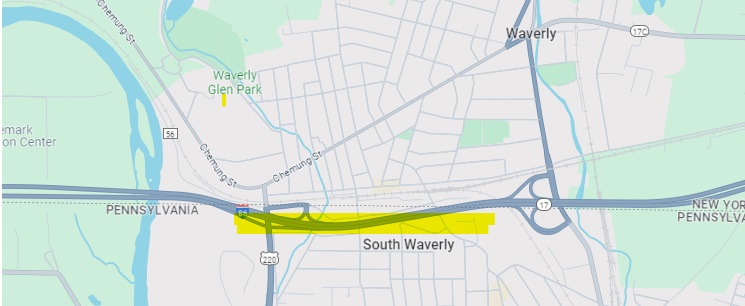
Highlighted. Blink and you miss it, folks! So do we get to put a pin in another US state? Technically, yes. But our rule of thumb is that we have to stop for a meal* for it to count, so no, not this time.
*Which raises another question, does frybread at Four Corners count as a meal? History will be the judge.
And so we dropped off The Mighty Sentra after nine days on the road. If this was Top Gear, I would wipe a tear from my eye and tell a moving tale of how I had come to love the brave little car as it soldiered on through tribulations and rough terrain, bringing us safely to journey’s end.
But, no. It was, at best, okay. The biggest tribulation we had was when a petrol pump card reader wouldn’t accept my credit card so I had to … use a different credit card. Scott of the Antarctic it was not. If I had any emotion as we handed the keys back in, it was a resolve to never again rent the cheapest car on the lot. Road trips are more fun with a good car!
And gladly it was a short walk to our hotel, the Hilton Albany. It was a very pleasant hotel, but to get to the rooms they have one of those elevators that are made of glass on every side, and that leave you with a sense of impending death. At least, if you have mild vertigo they do. I feel there should be a warning on the website when you book, but noooo. Ah well.
Checked in, bags in the room and white-knuckling it back down to ground level, we went for a stroll around the capital city of New York state.

Capitol building seen from Empire State Plaza
The Capitol is a handsome building. constructed in the late 19th century in a mix of Classical Romanesque and Classical Renaissance styles – you can see that the ground floor is different to the upper floors and no, that’s not for structural reasons, it’s because they changed architects part way through.
Also in shot is a tremedously big “I love New York” logo, created in 1977 as part of a campaign to encourage tourism. The logo is iconic and has of course spawned a host of
rip-offsloving emulations.
As our refrigerator door clearly shows

Next to the Capitol is Empire State Plaza, a self-consciously epic piece of architecture. Built in the late 1960s and early 1970s, it came about when the then-governor Nelson Rockefeller was embarassed by the condition of that part of town while escorting Queen Juliana of the Netherlands around the city on a royal visit. At the time the area of 98 acres (~40 hectares) was populated by about seven thousand immigrants, African-Americans and elderly people living in rooming houses. It was what we might nowadays call a vibrant inner-urban community but was at that time seen as a rather scruffy and seedy low-income neighbourhood.
So the government seized the land, moved the residents on, and built a selection of huge brutalist office and other buildings for civil servants to work in, and so that future governors would not have to look at real people’s lives.
They are pretty impressive buildings though.

Empire State Plaza looking south-west. Could you say they have an edifice complex?

Cultural Education Centre seen from the far side of the I Love NY sign
At the very south-eastern edge of the Plaza is the Cultural Education Centre of New York State. It sounds like something that ideologically unsound Russians would have been sent to during the Communist era, but actually holds the New York State Museum (as well as the NY State Education Department offices). We spent a pleasant hour or two looking through the displays, including a major exhibition on the building and operation of the Erie Canal, the express railroad of its day.

Cultural Education Centre seen across the reflecting pools in the centre of the plaza

Also at the Museum is a beautifully restored early-1900s carousel. It was a Saturday afternoon in summer but no-one was about, the carousel sitting sad and lonely on its terrace.

Mr Cow in front of the Capitol building seen from the south-east

A view of the Capitol gardens and statuary, this time without Mr Cow hogging the shot

Just across from the Capitol building is the city hall
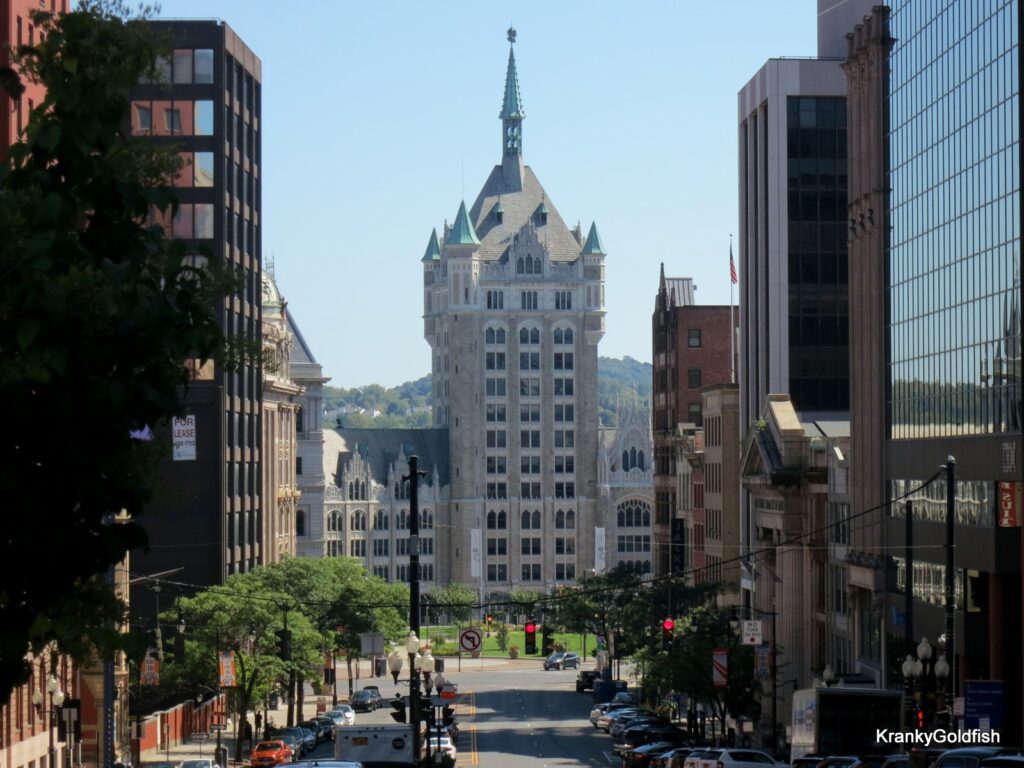
View down State St towards the Hudson River. The building at centre shot is the administration building for the State Universities of New York system, which has 65 campuses across the state. And yet none of them make it into the world’s top 100*.
* Not to brag, but our alma mater is in the top 100. Okay, a bit of a brag

For dinner that night we chose Emmanuel Thai, a little hole-in-the-wall place in downtown. Don’t get me wrong, I love American food. But ten days on the road of fried chicken, burgers, Philly cheesesteak and barbeque … it was a real pleasure to get some zingy fresh South-East Asian flavours for a change. And, luckily for us, Thai restaurants you can find almost everywhere.
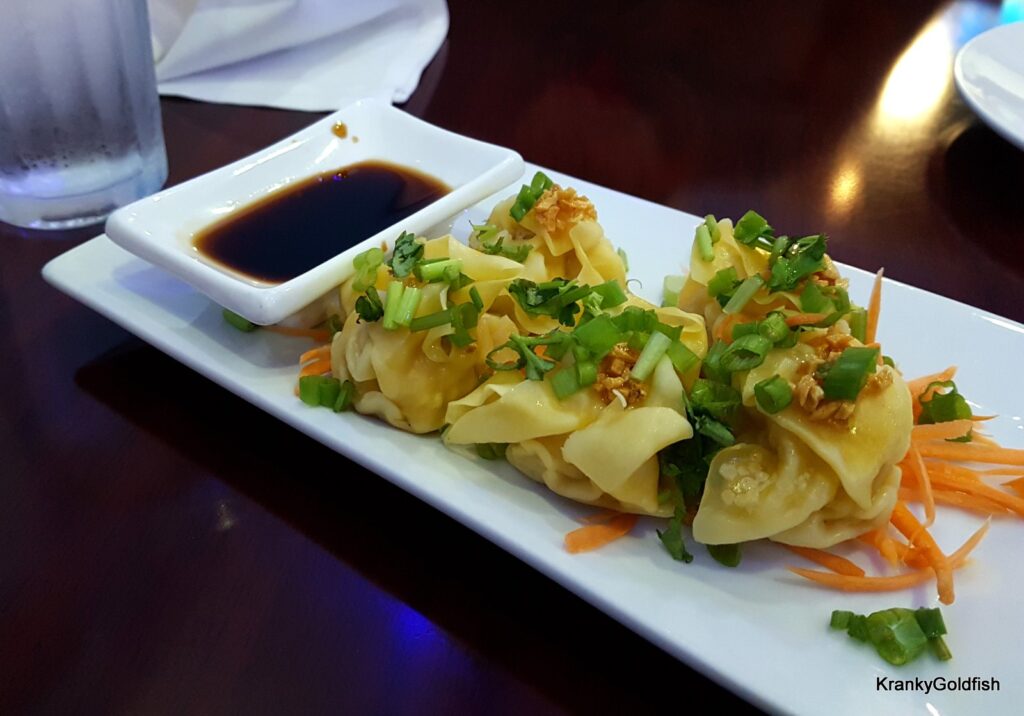
Steamed chicken and shrimp wontons with a vinegar and soy dipping sauce

Crying Tiger salad, grilled beef with green and red onions, lettuce, ground rice and a lemon juice dressing

Roast duck with a tangy tamarind sauce and fresh vegetables
It was all delicious, I am very glad to say. Our taste buds reignited, we hied off back to our hotel to sleep the last sleep of our road trip.
Tomorrow we have two diner meals in one day!, and see the Hudson River from a train.
-
Day 17. Niagara Falls to Corning
In which we travel to an enchanted grotto, by way of a grammar-ish joke, have a very healthy sandwich for lunch, sip some sweet wine and chow down on yardbird.
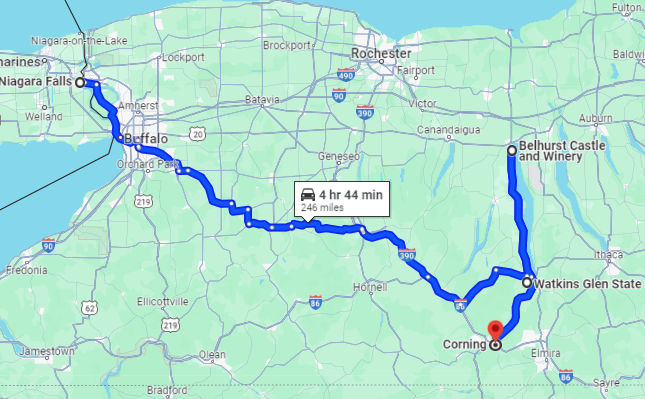
Up again, early, avoiding the overpriced foyer breakfast. Into The Mighty Sentra for our second-from-last day of roadtrip, and away we sped towards Watkins Glen. Which means we passed through …
Buffalo
Okay, the Buffalo sentence has nothing to do with our trip, but I can’t resist it. If you enjoy wordplay, here is some fun. If you don’t, then skip ahead top the next set of photographs.
“Buffalo buffalo Buffalo buffalo buffalo buffalo Buffalo buffalo”
The Buffalo sentence (yes, the eight consecutive buffalos above form a grammatically correct sentence) relies on the fact that the word “buffalo” has at least three distinct meanings as a noun as well as identically spelled adjectival forms.
Namely, “buffalo”, the North American bison; “Buffalo”, the city in New York State; and “buffalo”, meaning to bully or alternatively to bluff or deceive.
The buffalo sentence can therefore be parsed as –
Bisons from Buffalo, who are bullied by bisons from Buffalo, also bully other bisons from Buffalo.
The English language is totally crazy and I love it!
Watkins Glen
Watkins Glen State Park is a valley, a little south of Seneca Lake, with a stream running though it. This description thoroughly fails to do justice to one of the most beautiful pieces of nature-crossed-with-the-works-of-mankind that we saw on this trip.
Just south of the village of Watkins Glen, the park has plenty of parking at the entrance and more at the south entrance. Parking is $10 or you can probably find some free street parking and walk a ways, but that’s not really nice to the people who actually live there. Don’t be cheap, spring the ten bucks! It’s a popular place for picnics, hikes and has a large number of campsites and a small number of cabins you can hire.

Walking from the main entrance towards the Glen
Originally the stream running down the valley powered the local flour mill; before that it spent many, many thousands of years carving a path through the hills, creating a series of cliffs, waterfalls and pools that are not especially huge – no Niagara here – but are just remarkably beautiful.
The Glen has been open to tourists since the mid-19th century, originally in private hands but from the early 1900s owned by New York State.

From the entrance you make your way up a series of paths and steps built into the side of the cliffs. The path is not all that long, probably only 2km (1.25 miles) but it’s very windy and there are lots of steps. The steps, paths and bridges have been constructed in a way that is perfectly sympathetic to the natural lines of the glen itself. It’s beautiful design and excellent engineering rolled into one execution.
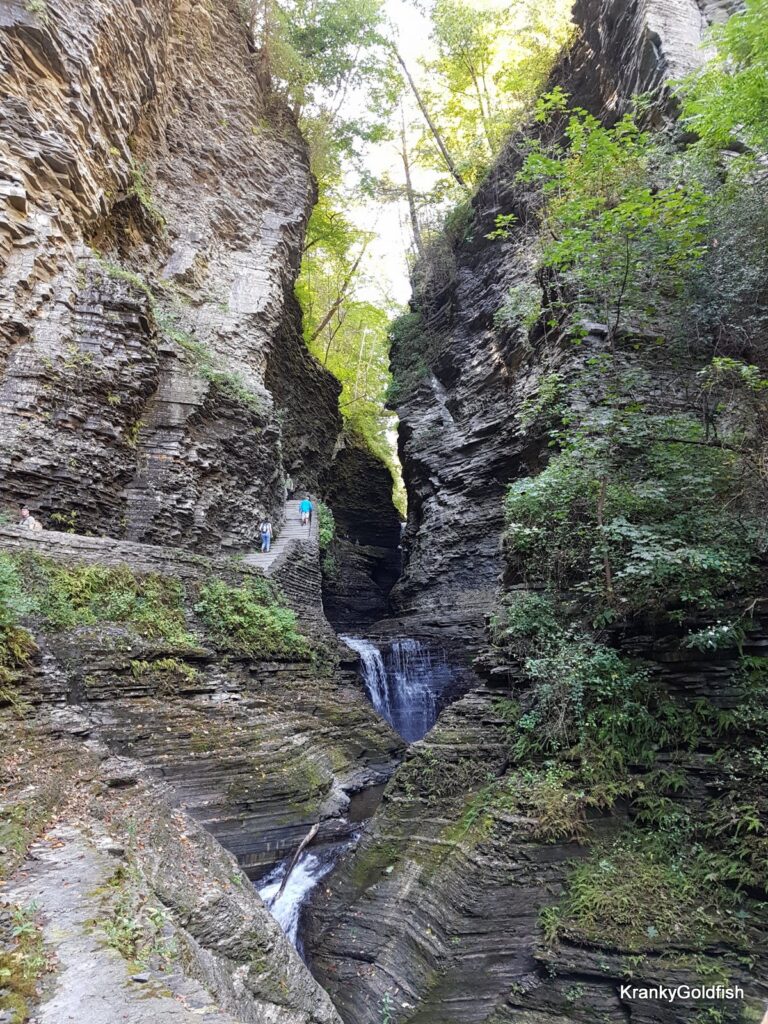
Lots! of steps

Looking back towards the main entrance, partway through the Glen

It took us a bit over an hour to walk along the paths to nearly the top of the trail, and then back along the top of the Glen which is a much easier walk but has no views. Take your comfortable shoes, and stretch out your hammies before you set off.

Many of the walkways were built by workers in the Civilian Conservation Corps – a New Deal organization that provided work for unemployed men in the depths of the Great Depression. In some places you can see bootmarks in concrete nearly a century old.

It’s quite tempting to imagine elves and halflings making their way through the incredibly beautiful landscape. And I did.
So slightly puffed and tired of foot, we had some extremely healthy salad sandwiches at a small cafe in Watkins Glen proper and moved on to our next touristy endeavours.
Wine Lake Wine
The Finger Lakes are some very pleasant lakes in northern New York state. The lakes are nice to look at, pleasant to boat on, and home to some of the best regarded wineries in the US. The Napa Valley winemakers would no doubt beg to differ on that; but the Finger Lake region has the advantage of a cool climate and a long maturing season that enables wine of subtlety and complexity.

We motored on up to Belhurst Castle hotel and winery. The Romanesque Revival buildings were constructed using local sandstone and built at the end of the 19th century – a prosperous time in New York state. It’s a popular destination for weddings and the wines are quite good. I especially enjoyed the dry sparkling wines although the Riesling was a little fruity for my personal tastes.

View across Seneca Lake from the winery

A little further south, still on the lake, is the Glenora Wines winery and tasting rooms. They have a dazzlingly huge range of both grape- and fruit-based wines. Again, the sparkling wines were my favourites – sip and spit only, alas, as I was driving – with much of the rest of the range being a bit on the sweet side for me. But, hey, Americans love their sweet drinks.
Corning Where?
Our destination for the night was the town of Corning. And, yes, it is the home of Corning Incorporated, the company that makes all those glass and ceramic vessels we have in our kitchens.
We stayed in the Radisson Hotel, a perfectly pleasant and reasonably priced lodging. It’s also conveniently located near the town’s main shopping drag, so we moseyed on down, walked the length and back again before deciding we were in the mood for some ‘cue.

Slammin’ Jammin’ BBQ does what I think of as Memphis style barbecue (although I am no expert on these things). The food was hot, the beer was cold, the barbecue sauce was a bit tangy and a little sweet, and the staff were friendly and answered all our questions about the local beer and even gave us a few tasters to help us decide what we liked. We chowed down.

Half a chicken, hot smoked, with fries, grilled sweetcorn and cornbread. The chicken was smoky, savoury and juicy.

Trying to be healthy, we shared the chicken and ordered a large salad to share. Not entirely succeeding, we ordered the salad that came with little fried chicken bits on top. And some cheese. And the dressing was ranch, so … well, no-one’s perfect.

And, on the way out you can buy a treat for your four-legged friends.
So that was another really good day, lots of walking, some spectacular scenery, sipped some good wine and some not-quite-as-good, and a nice meal.
Tomorrow, the end of the road trip with some quality time in the capital of New York, where we see some really big buildings and a giant heart.
-
Day 16. Niagara Falls
In which we look at, sail up to, walk around underneath, and look at the river flowing out from, Niagara Falls. Today is all about the Falls. Mostly.

Be careful Mr Cow! We got up pretty early to get a good start at a pretty full slate of Falls-related activity, starting with the traditional boat ride. Tourist tip – grabbing a quick breakfast and coffee at the coffee shop in the hotel lobby was eye-wateringly expensive even by tourist-trap standards. Maybe stock something from a supermarket to keep in your hotel fridge if you’re passing by one.
Anyway, heading along the clifftop to the ramp down to water level to get to our boat, what did we see?
Not gonna lie, this is one of my favourite photos from the day, and Niagara Falls is pretty darn photogenic. The quite large ferry made tiny, tiny! by the enormity of the falls, lost in a sea of mist and the tremendous sheen of the early morning sun on the water.
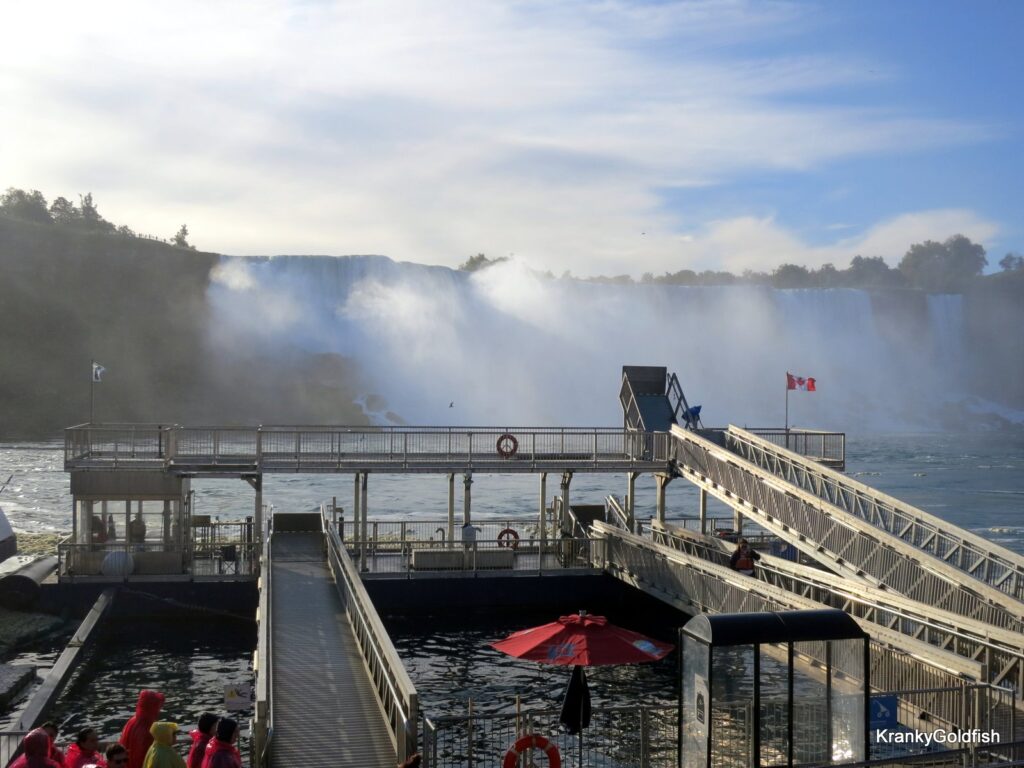
Down at water level awaits the dock. “Maid of the Mist” is the ferry that leaves from the American side of the falls; the Canadian one is the much less romantically named “Niagara City Cruises“. There’s a wide, not-too-steep ramp heading down from cliff level and an elevator if you’re not feeling so energetic. We walked down the ramp getting to the boat, and elevated up coming back.

And from water level you get a dramatic view of the falls.

Our ferry took us along the American side, getting close up and personal with the American Falls (on the left of the photo) and Bridal Veil Falls (the very thin falls to the right of the photo, barely separated from the American Falls. You’d have to be told to know they were separate).
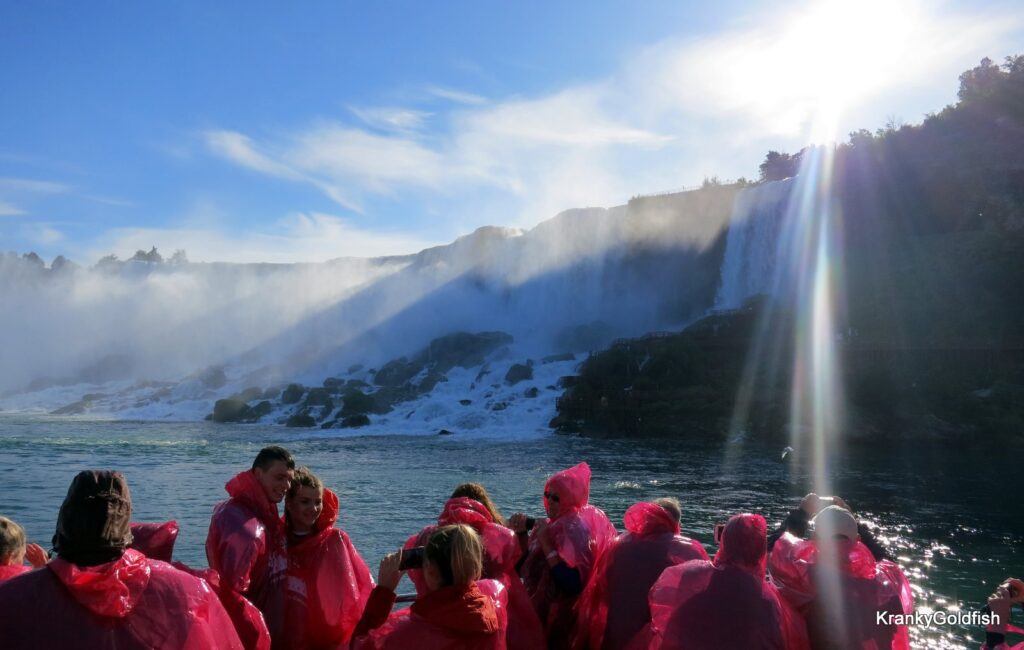
Tourists are provided with ponchos (red if you are on a Canadian boat, blue if American, of course), because it will get wet, and, yes, make sure you are careful with your phone or camera. Gladly my trusty Samsung S-something, I forget exactly which one I had then, S5 I think?, was water-resistant.

And you get pretty close up to Horseshoe falls too, see the photo near the top of this page. This is as close a photo as we got though; there’s a line where water-resistant stops and common sense starts, and that’s when you put your phone in your pocket and just enjoy the ride. Which was … I mean, I’m needing to break out the thesaurus here. Niagara falls is immense beyond human capacity to understand; stunning in its power, spectacular in its aspect.
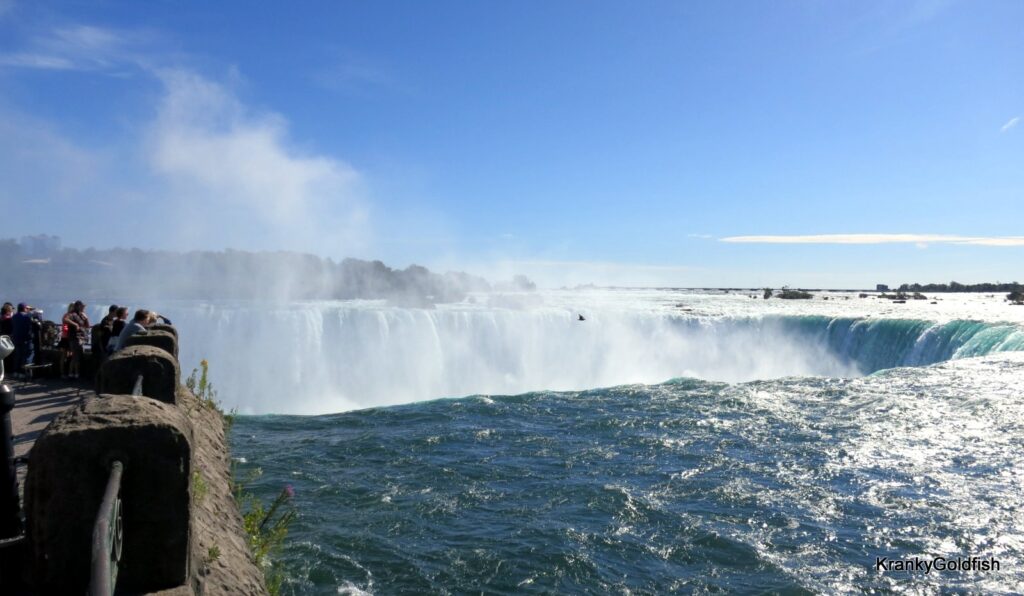
Boat ride over, we moseyed on up to the top again, okay, elevated, and walked along the cliff rim (safely behind large railings as you can see, don’t worry) to a point just past the falls. And again; awesome, magnificent, a constant movement through repeating patterns of flow. We stood there and just watched, trying to absorb the spectacle.

Okay. Watched and took some photos. This is, I think, my second most favourite snap of the day. Something about that light on the water really works for me.

Also on our agenda was the “Journey Behind the Falls“. CAD24 (as of the time of writing) gets you access to a series of tunnels behind the falls with some interesting (if rather obscured by falling water) views out, and some interesting placards of falls-related facts.

More interesting than the tunnels, though, is what they lead to – an observation deck halfway up, or down depending on how you like to look at things I guess, with even more <reaches for thesaurus> compelling sense of the size and power of nature. You don’t get much closer than this short of going over the falls on a barrel. Which is frowned upon.

Speaking of going over the cliffs on a barrel, one of the other favourite Niagara Falls tricks is walking over it on a tightrope. The oldey-timey thrillseekers didn’t do it over the falls as such, that was far too wide to do using 19th century ropes (although that has been done more recently using 21st century ropes). They did it over Niagara Gorge, a few kilometres downstream and easily reached by local commuter bus. A ramp leads down from cliff level to just above river level, where White Water Walk runs alongside for some distance and provides some great views of the river.

All the water that comes over the falls has to go somewhere, and this is where.
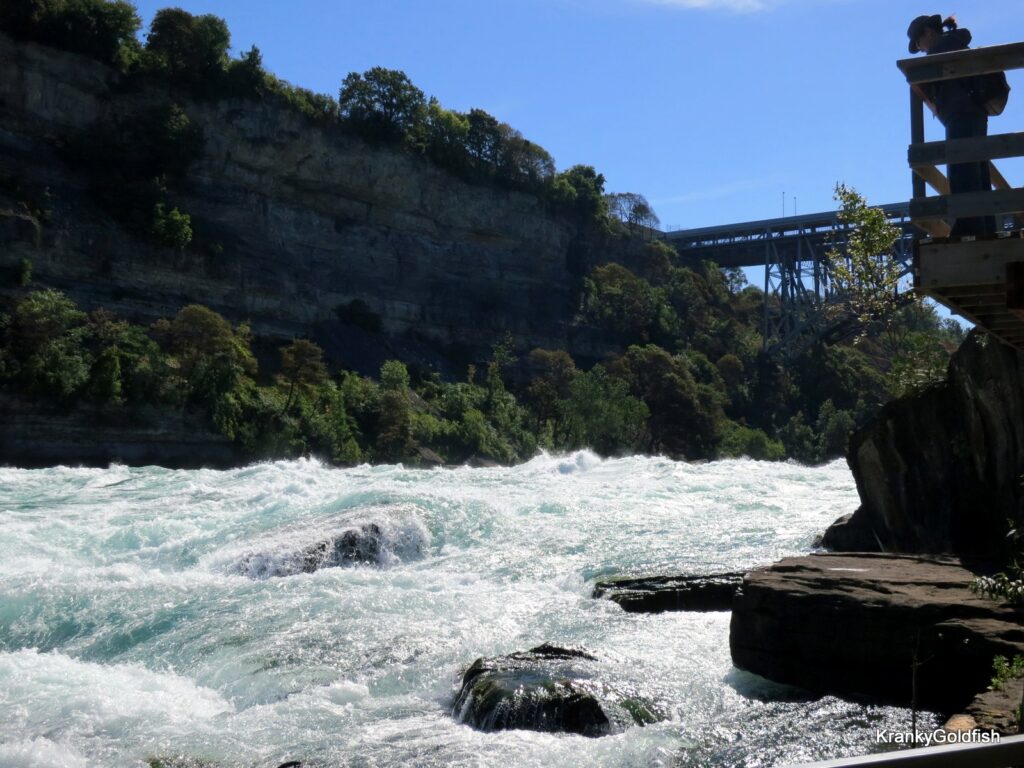
Millenia of water flow have carved out a great gorge. Which, again, when you get close, is magnificent and no little bit scary.

The water flow generates standing waves that rise feet above water level. The gorge is a Class VI rapid, which is defined as “constant threat of death because of extreme danger”.
Yep, sounds about right.

A busy morning of boating, tunneling and white-water walking had given us an appetite for a late-ish lunch. A few blocks from the waterfront is a Works Burger store. Yes, it’s a franchise, but a good burger and a cold beer is a nice lunch even if there are dozens of other identical stores across Canada.

Doreen, attempting to be healthy, ordered the All Dressed Salad, which is a beef patty on a salad. I think she underestimated the amount of bacon that might come with it.

I had the Blues Burger with an elk patty, because as I always say, when in Canada, eat elk! The elk was lean and gamey, as you would expect, and the blue cheese dressing on it worked very well.

Ah, Canada. Even your condiments are foreign and exotic. “Ketchup aux tomates”, what on earth might that be?

Lunch dealt with, we had a few hours to kill and wandered up to the Niagara Falls Military Museum. Built in the old militia armory*, it’s a pretty good example of an amateur local museum. There aren’t spectacular tanks and aircraft, but lots of personal kit, small arms and artifacts donated by the local people who went to war, and in some cases if they didn’t come back, by their families.
We had to phone the number on the sign out front to get let in; the local volunteers were inside, hard at work, but had forgotten to unlock the door. When we were in we had a good chat, and bonded over the fact that British leadership in the Second World War had badly mistreated both Canadian and Australian troops. Ah, Britain; bringing people together through shared grudges.
* Remember, the US and Britain had been to war in the 18th and 19th centuries, and as recently as 1866 there was an attempted (if hilariously incompetent) invasion of Canada by Irish rebels operating from the US, so having armed forces on the border was a natural thing to do.
Dinner that night was at the Queen Victoria Place Restaurant, which has a fantastic view of the falls at dusk.
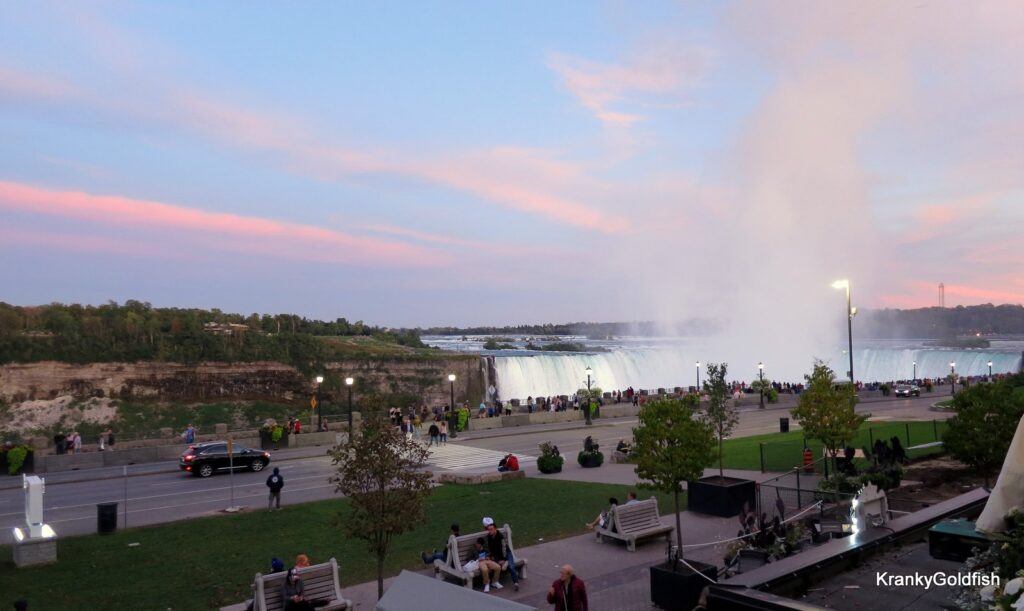
The food was okay, but honestly I would go there for a drink to enjoy the sunset and eat somewhere else.
So, Niagara Falls. A giant tourist trap, yes. Also one of the great wonders of the natural world. I wish I’d saved some superlatives for now to wrap it up, but I’m all out. It’s magnificent, and well worth a trip.
Tomorrow we hit the road again and see the American Rivendell.
-
Day 15. Hamilton to Niagara Falls
In which we drive two hours before breakfast, do two more things in Rochester, and end up in a room with a view.
Today’s story starts a day or two earlier when we were roughing out our activities for the Hamilton to Niagara leg. My contribution, as it so often does, consisted of checking Rochester for rare, unique, or at least very tasty things to eat. And I found two things that Rochester is famous for; or perhaps in the case of our first meal there, infamous. Which led to a dilemma; two things to eat, but only one lunch.
“Why don’t we go there early, and have one of them for breakfast?” suggested Doreen.
You can see why I love her so much.
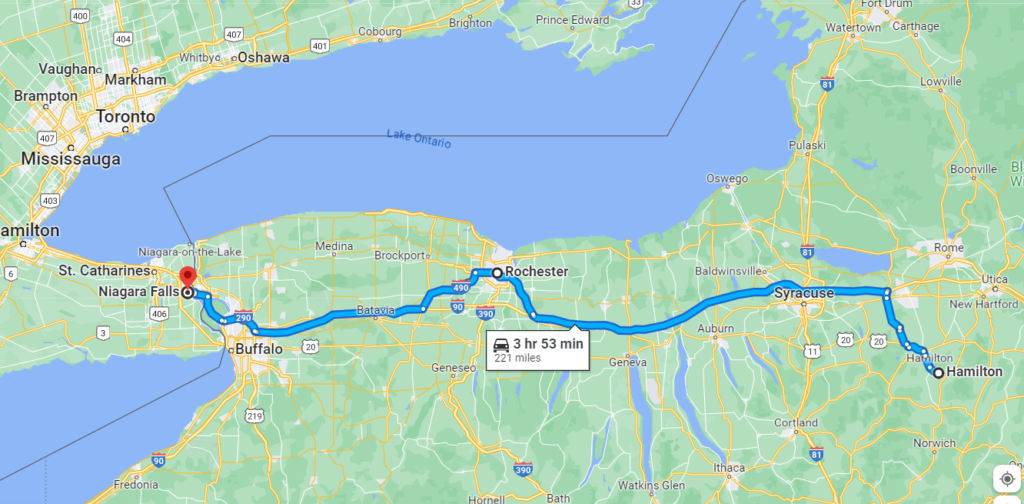
It would take two-and-a-bit hours to get to Rochester, so we were up very early and checked out shortly after 7am. Into The Mighty Sentra we hopped once more, and drove through upstate New York, skirting Syracuse and travelling through beautiful farming country.

Scattered through upstate NY there were wind turbines standing tall across the landscape.

Also standing tall were the late summer crops. Here we see … wheat? … grains of some type? Probably? I don’t know, I eat them, not grow them.
Breakfast In Rochester
By a bit after 9am we had arrived at Rochester and headed for our first destination.
Rochester was once a thriving industrial city built on the prosperity of Eastman Kodak. Generations of locals grew up, worked and retired spending their entire lives employed by Kodak. Kodak also famously decided in the early 2000s not to pursue digital photography – despite having developed some of the most advanced digital cameras of the time – because they thought it would cannibalise the photographic film sales that had made them rich for a century and more.
Spoiler – that was not the right decision.
Rochester, therefore, has now entered its post-industrial future. There are still lovely leafy suburbs and a leading university and hospital system, but much of the city is in decline.
Perhaps symptomatic of the decline is Nick Tahou Hots. The building it is in was once the elegant terminal of the Buffalo, Rochester, and Pittsburgh Railway. Now, it’s kind of run down.

Nick Tahou is famous for the invention of the Garbage Plate, a carby, meaty pile of misassorted food designed to keep a hungry person going all day or all night.
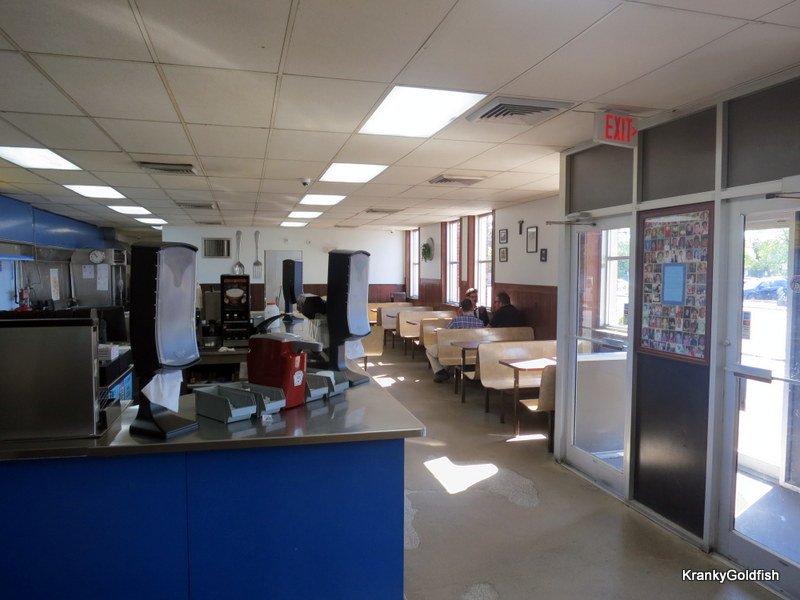
At 9:30 or so on a weekday morning, things were pretty quiet. A small group of hipsters and a couple of partied-out party girls were all the customers in the place. And, us, of course.

This is where the magic happens.
A Garbage Plate is a couple scoops each of cottage fries, macaroni salad (not mac ‘n’ cheese – you get a mac ‘n’ mayo salad with a few tiny flecks of carrot and cabbage served cold), onions, yellow mustard and beef mince sauce that’s halfway between gravy and chili. You can get it with sausages (hot links, the “hots” in the name), a burger or cheeseburger or veggie burger, fried egg and lots of other combos. It’s a pile of hearty, old-fashioned goodness and you either love it or are appalled by it.
And lots of locals love them! You can find garbage plates all over the Rochester area.

Not gonna lie, cold mac salad and chili beef with a burger patty in between is a bit of a weird combo. But it’s a genuine unique local specialty, and after a couple of hours driving I was in the mood for something filling. I have to say it went down a treat, even before 10 in the morning. The real test is, would I do it again?
Yes. Yes I would. Don’t judge me.
So I don’t know, maybe Nick Tahou Hots is really sympotomatic of the Rochester spirit, a plucky underdog tenacity that takes whatever hand fate deals and makes the most of it. This is not a sociology blog, don’t ask me.
Our Kodak Moment

Another must-do in Rochester is the George Eastman Museum. Nestled in one of the leafy parts of town I mentioned earlier, it is a fantastic collection of historic photography hardware together with exhibitions of movie and photography history – when we were there a suberb collection of Loony Tunes material was on display.

The camera collection is encyclopaedic and contains classic cameras from history, even some historic ones that have been to space and back.

Cameras can be almost an afterthought – they are the tool we use to capture bits of history, we take a happy snap or two or an “I was there” shot. But sometimes history is defined by how we capture it. Photographs can drive history, not just record it. Seeing a collection like this – spy cameras, satellite cameras, cameras used in mountaneering or journalism – helps even a novice like me build some understanding of the role they have played in defining the history we remember.

The museum is built on the grounds of George Eastman‘s mansion and estate. The museum proper is in a new building to the rear of the old mansion, and the mansion itself has been preserved and can be visited on the same admission ticket

As can the gardens, which are absolutely delightful and were in full late-summer bloom when we visited.

The mansion itself is also well worth a look. Constructed just ten years later than the Breakers, it is completely different in style. While still a statement of wealth and power, it is simple and elegant in form where the Breakers is loud and gaudy. I don’t know if the ten years between the end of the Gilded Age and the start of the Progressive Age made the difference, or if it’s a Rochester versus New York City kind of difference, or if George Eastman just wasn’t trying to make as big a statement as Cornelius Vanderbilt II. But I found myself appreciating the Eastman mansion rather than being dumbfounded by it.
And, yes, that’s a real elephant head in the entry hall. Eastman was a great hunter, as was the style at the time. The word “Kodak” may have been partially inspired by the mighty Kodiak bears he hunted – Eastman said that he wanted a name that was short, simple, unique and that inspired a sense of strength. A marketing name practice that continues to this day – is anything mightier than viagra, I mean Niagara?

And the mansion of course is lovely. The floors are marble, the stairway is refined, and even the smallest urchin could not get their head stuck between the verticals.

The parlour and pool room makes you want to sit and chat, and maybe play a frame or two.

The dinner table seats six! I mean I’m sure it could extend out, but six is practically normal.

And the bedrooms are nice and pleasant too.
One last fun fact about the house before we move on. In 1919 George Eastman decided that the conservatory’s proportions were not to his liking. Too square, he wanted it more oblong. The house was cut in half; the north half was raised on hydraulic jacks and moved nine feet and six inches – just under three metres – so the conservatory could be extended. The renovation cost almost as much as the original construction.
So, on to lunch.
Well hot dog!

dogTown made it onto a top 10 list of hotdog joints, I mean yes that was in 2015 but it counts for something. It’s a simple little place half a mile out of downtown, there’s parking on site and we went there for a late lunch.

The menu is enormous. They start with good quality beef hot dogs, add them to custom-cut French bread (not hot dog buns – normal buns would not be able to cope with the toppings on offer), and finish with a huge range of options to top the basic package. Chilli beef sauce, onions, peppers, sauerkraut, mustard, slaw, different cheeses, bacon, baked beans (sure, why not?), tzatziki (a little odd), olives, mushrooms, pickles, and more. They also do sandwiches, burgers and garbage plates. They’re the whole package.

We ordered and moved out to the nicely gardeny outdoor seating. There are tables inside too, but it was a very pleasant day.
We ordered a Cincinnati Red Dog (a basic but classic chili cheese dog) and a Mongrel Dog (onions, peppers, kraut, mustard, pickle relish and melted cheese).

The Mongrel Dog. Served with a pickle, and may I say how much I enjoyed the prevalence of pickles in American lunches. A nice perky fermented cucumber is delicious at any time, and all the more so as a contrast to a somewhat meaty and cheesy hot dog or sandwich.

The Cincinnati Red Dog. You can see why a normal hot dog bun would not fit the bill here.

This is my hot dog face The hot dogs were indeed delicious and huge, and spectacular value at $3.50 – $4.00 (plus tax. Why on earth don’t Americans include tax in the display price?). My only mistake was trying to fit a whole one in my mouth. Small bites from the side is definitely the dignified way to approach these dogs.
It’s a WonderFall Life
So after a good morning’s culture and two classic Rochester meals we headed off again.
It’s not that far to Niagara Falls. We arrived in the middle of the afternoon and checked into our hotel for the next two nights, the Sheraton Fallsview.
We had booked a “Fallsview” room, which is what it sounds like. We opened the curtains and …

Wow That’s the American falls on the left, the Canadian falls on the right, and Goat Island in the middle. The border between the US and Canada runs down the middle of the Canadian falls.
And don’t worry, the rooms are well insulated and from the 20th floor there is just the tiniest hint of a rumble of background noise.
We did go for a quick walk along the waterfront, and it’s very nice, but tomorrow’s photos are much better so I’ll make you wait for those.
Ridiculously huge and majestic waterfalls aside, what is Niagara Falls the city like? We were on the Canadian side – the views are just completely better than from the American side – so we went for a walk in our very first Canadian stopover.
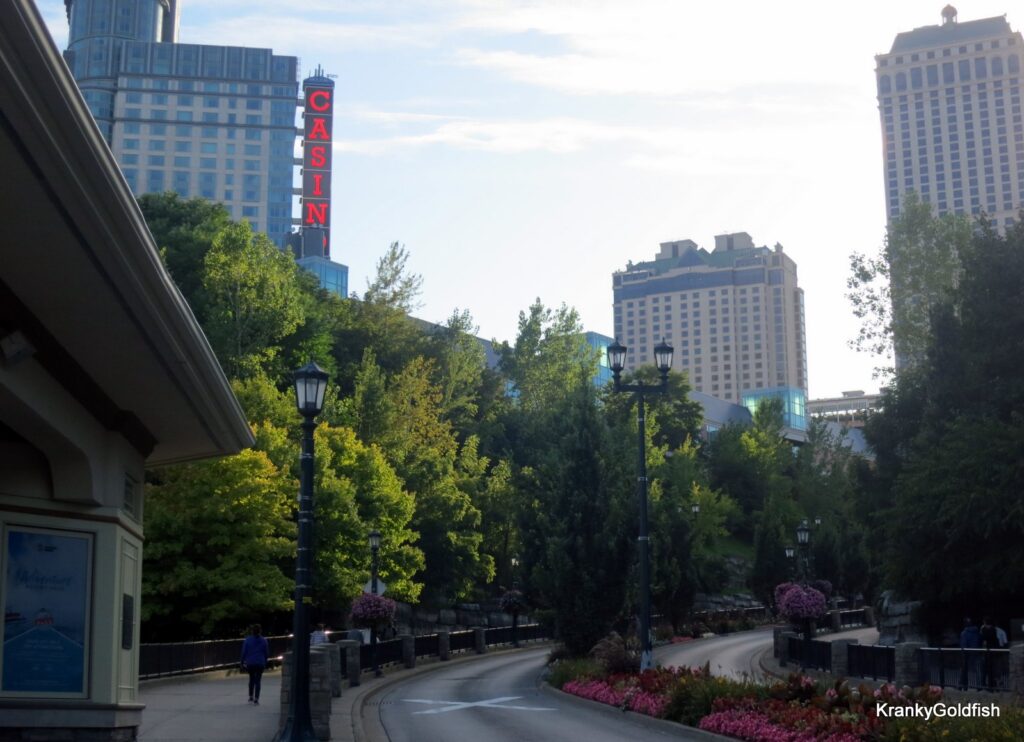
Unsurprisingly the city is dominated by tourism, and the skyline is dominated by hotels, especially along the waterfront. Very, very tall hotels – everyone wants a view of the falls.
Just around the corner from our hotel we stopped into the Niagara Brewing Company for dinner.

It’s a nice venue, brewing done on site, plenty of seating, a welcoming atmosphere and friendly staff.

Nice beer, too – we enjoyed the lager and the peach radler, both very soothing after a long day.

Say cheese And we also had our first poutine. It seems rather fitting that a day that started with a Rochester Garbage Plate should end with a pile of chips covered with gravy and cheese curds. They don’t look like much, but as I always say, when in Canada eat poutine, so away we went.
Not bad, not exciting, really, I thought to myself. Then looked down again a few minutes later and found that I had demolished the generous bowlful without even trying. They are compulsive eating, these little treats of carbs and fat covered in salt and salty gravy. Don’t tell my cardiologist.
But anyway, what about the city? Population one hundred thousand or so, dedicated to tourism yes, but it’s Canada. We were looking forward to a stroll through a lovely, dignified medium sized city, tasteful, understated, because that’s the Canadian way.

Oh come on. You knew I was setting you up with that last sentence. Oh. Canada.
It’s as if they tried to make a new Vegas, tried to cram every bit of tacky glitz and bling in the whole country into four or six blocks for the tourists to … enjoy?

But, it’s Canada, so instead of Penn and Teller and the world’s most spectacular fountain show, you get … bowling.

And a wax museum. I mean, yes it’s the Wax Museum of the Stars, but even so we gave it a miss. Back to the hotel for one last look at the falls before a good night’s sleep.

Only to find that they have tried to bling up the waterfalls too. The colours change as the evening passes, but honestly I could do without it. When their national anthem sings of “Great prairies spread and lordly rivers flow”, I didn’t picture it coming with a light show.
Ah well. Grumpy old guy nature-should-be-natural grumblings aside, it was a lovely day with lots of fun stuff. Tomorrow we get our tourist on all around the falls, walk along the gorge downstream, ride on a boat, and pass a lot of water.
-
Day 14. Middlebury to Hamilton
In which we have a maple syrup breakfast, go for a stroll in a historic town, get ferried across a lake, and see cows and cannon.

After a pleasant night’s rest in our room, we headed down to the very charming dining room for breakfast.
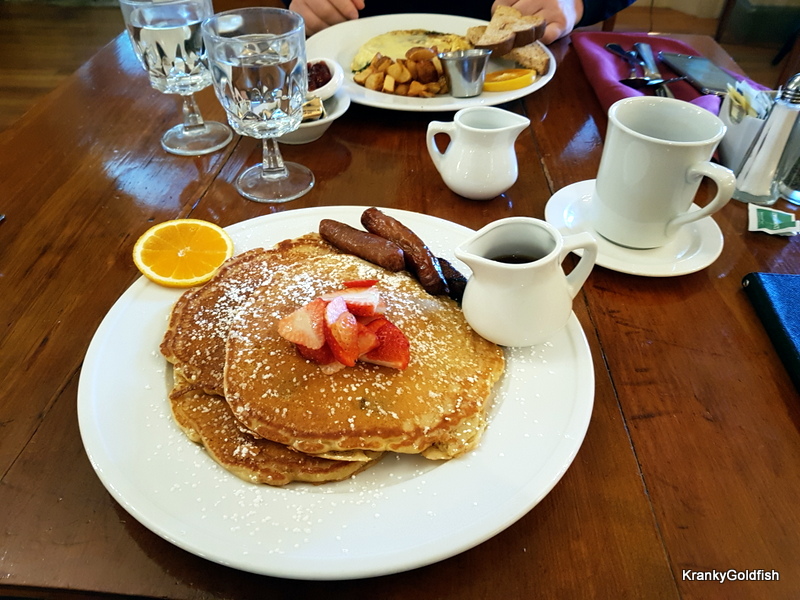
And as Doreen says, when in Vermont, have maple syrup with your breakfast. Pancakes, fruit, and maple syrup I get. They make sense, although are arguably a dessert. But sausages? Sausages and fruit, and syrup? American breakfasts baffle me sometimes. But I guess I don’t have a sweet tooth, so maybe it makes sense to other people.
Also, Doreen says the sausages were a bit dry. She regrets not choosing the bacon.

I had a more savoury breakfast, a hearty three egg omelette with cheese, veggies and herbs, and some cottage fries and toast as well, because why not? It was all very yummy, and I would like to note here that we had quite a small lunch.
We allowed some time to go for a stroll around Middlebury. Nowadays it’s most well known for Middlebury College, but in its history it has been the seat of the Vermont legislature and was in the early 19th century one of the largest towns in Vermont. Which, not to be critical, isn’t all that hard, as the population of the whole state is only about 650,000 now.
But it’s a lovely place, a classic little New England town and well worth a look around.

The Congregational Church is a beautiful building, perched on a rise on Main Street. Of course it’s the kind of town that has a Main Street!

The Episcopalian Church, nestled on the town green just a couple of hundred yards from the Congregationalists, is for a change not a building made out of wood.

Middlebury is the kind of town where businesses fill their window-boxes with bright flowers. And they do it unironically.
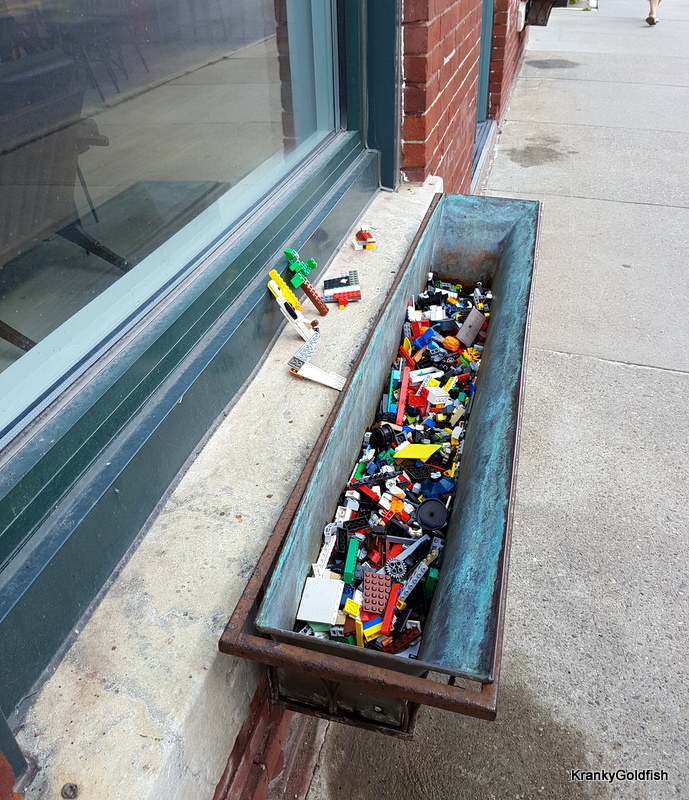
Okay, not all the businesses put flowers in their window-boxes. This one has a big collection of construction bricks so the younglings can have a play while the parents are inside shopping.

Continuing along Main Street, we came to the bridge over Otter Creek, with a view of the falls and Riverside Park. Everything is picturesque!

The town library is a dignified building, of substance and solidity. You can bet that in another hundred years it will still be here. Although by then it may have been adaptively re-used into a steakhouse.
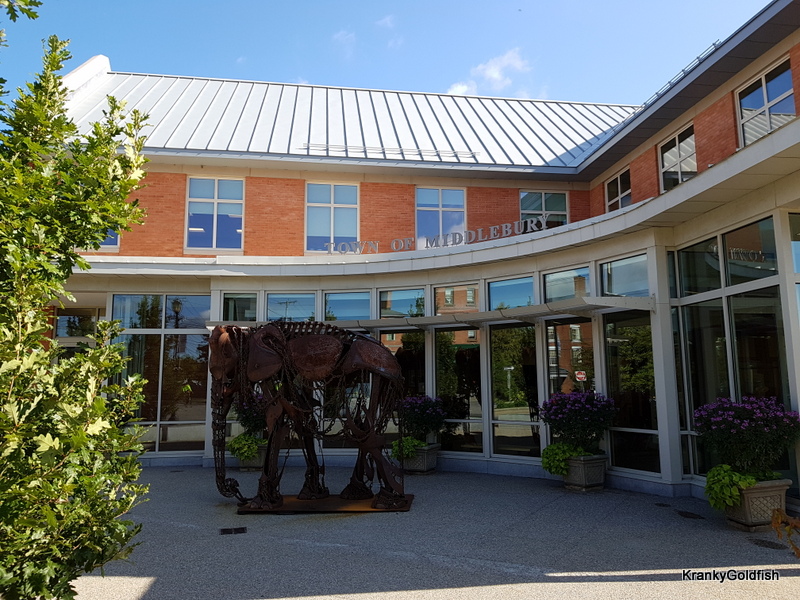
The city offices, on the other hand …. I mean, at some point in the middle of the 20th century, architects just kind of gave up on style and went full bland utilitarian, or, worse, brutalist. You can bet that in a hundred years, this will have been bulldozed and replaced with something else. Maybe then “Gravity” the Asian elephant will no longer be in the shadows.
Hopefully.
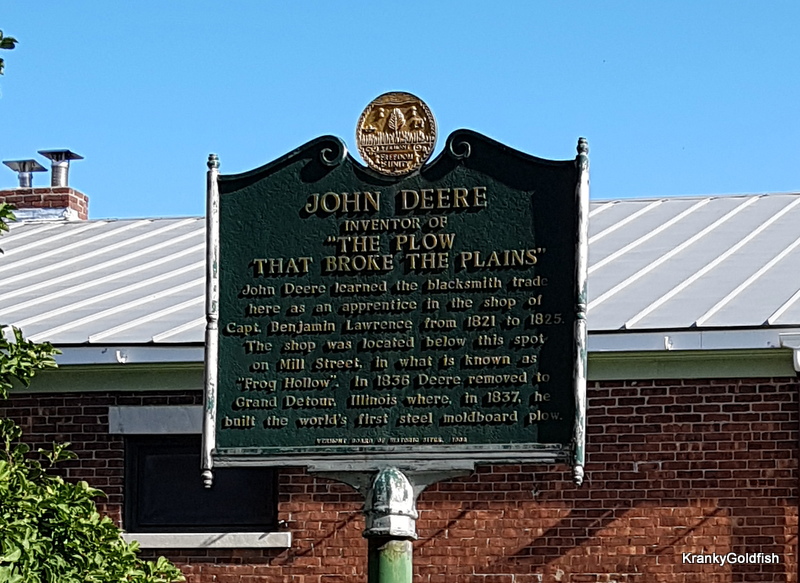
Apart from the college and legislature, the town is famous for something that didn’t happen. John Deere wasn’t born here, and he didn’t invent the self-scouring plow here. But he lived here for a few years and learned blacksmithing here. So, there’s that.

And other historical things happened here. Anyone who thinks that activist judges are a recent phenomenon, think again.

Walking a ways further we came to another bridge over the very charming Otter Creek.

The texture and shapes of the waterplants in the current, contrasting with the pebbles and rocks on the bank, caught my eye, and I leaned over for a close-up.

Yet another stately building, this was the Inn on the Green when we visited but has since closed.
So having had a very pleasant stroll, we checked out of the Middlebury Inn. Into The Mighty Sentra we hopped and motored off towards our next destination, Fort Ticonderoga. We needed to cross Lake Champlain to get there and had to make a choice. There is a bridge north of Crown Point, more or less due west of Middlebury, or a ferry right by Fort Ti.

We chose the ferry, and were really glad that we did.

A ferry has more soul than a bridge. We got to queue for a couple of minutes, and then drive on, park and get out of the car and admire the waters of the lake. A cool breeze blew on our faces, the sun was shining down from the blue sky, and it was a lovely restful moment as the ferry put-putted across the lake. Sure, it cost a few bucks extra, but it was well worth it.
We kept our eyes peeled hoping to catch a glimpse of Champy, the Lake Champlain monster. Sadly, he was not to be seen that day. Some people – people with small imaginations – think that Champy is a myth, or a large river snake, or maybe a stick. But we believe.

There was a basket of fruit for travellers to help themselves from, and the chance to buy a commemorative t-shirt. You don’t get that on a bridge.

Mr Cow enjoyed the trip too. But I do wish he would keep his eyes on the road.

Fort Ticonderoga was first built by the French as Fort Carillon in 1755, early in the Seven Years War (known in America as the French and Indian War). It was built on a bluff above a narrow part of Lake Champlain at the nearest point to Lake George, and it commands the passage of boats on the lake.

The fort closes for the winter each year. Upstate New York gets very, very cold. The location was of great strategic importance, as Lake Champlain is connected by rivers and lakes to the St. Lawrence River just down from Montreal, and Lake George is just a 10 mile portage from the Hudson River which leads directly down to Albany and New York City. At the time, New England and upstate New York were complete wildernesses away from the coasts and rivers. For a British or French army to attack to or from Canada, the lake and river system was the next best thing to a highway.

A view from the bluff just below the fort, looking south along Lake Champlain. You can see how the height and location gives great visibility over the lake.
For a fort whose effective life was less than 30 years, it saw a lot of action. The British attacked it unsuccessfully in a major seige and assault in 1758. Both sides retired for the winter, and the British attacked again in early summer of 1759, this time successfully.
In 1775, at the very start of the Revolutionary War, a force of American militia led by Benedict Arnold and Ethan Allen surprised the British garrison and took the fort. The cannons of the fort were transported, in an epic slog through mud and snow in the winter of 1775-6, to Boston where they were instrumental in raising the British siege. So, the guns of Fort Ti, in a roundabout way, saved the American revolution.

In July 1777, British troops returned and occupied a nearby mountain that overlooked the fort. The American garrison, in an impossible position, withdrew before the British could attack, and the British moved in again. In September that year, the Americans returned and tried one last, unsuccessful attack.
And that was it for Fort Ti.
The fort was abandoned by the military in 1782, was stripped for building materials by locals, and fell into utter disrepair.

In the early 1900s the site was acquired by the wealthy Pell family, who restored the fort and opened it to the public as a historic site.
The thing was, they restored it in a way that it never was. The walls, ditches and building are all in about the right location, sure. But the original walls were wood front and back with soil filling between them. Work started on facing them with stone but it was never completed. The new fort is more solid and much better maintained than the original, and I would guess that the replica buildings are lighter and airier.
It’s an altogether romanticised version of history. And maybe that’s how we prefer it.

Looking through the main gate of the fort into the courtyard.

View from the rampart of the fort looking west. The height to the left of the shot is the start of Mount Definance, where the British placed their cannon in preparation for the 1777 attack. The fort was perfectly placed to cover the lake, but having higher ground nearby was a fatal flaw.

Detail of the moulding on one of the cannon. Most of the cannon are real 18th century pieces, but as they were acquired in the early 1900s they are not the originals from the fort. From the fleurs-de-lys on the coat of arms it does appear to be French.

Interior courtyard of the fort, barracks building on the left, smithy and workshops straight ahead.
The barracks building contains a great collection of military and civilian 18th century artifacts and displays, showing the history of the region and detailing the lifestyle of locals both native and colonial at the time. I spent well over an hour there and wish I had time for more.

A few times through the day, local re-enactors stage demonstrations of activities of the time. The theme changes, but when we were there it was the process of loading and firing the cannons, wearing the uniforms of French artillerists. Here, the audence is summoned.
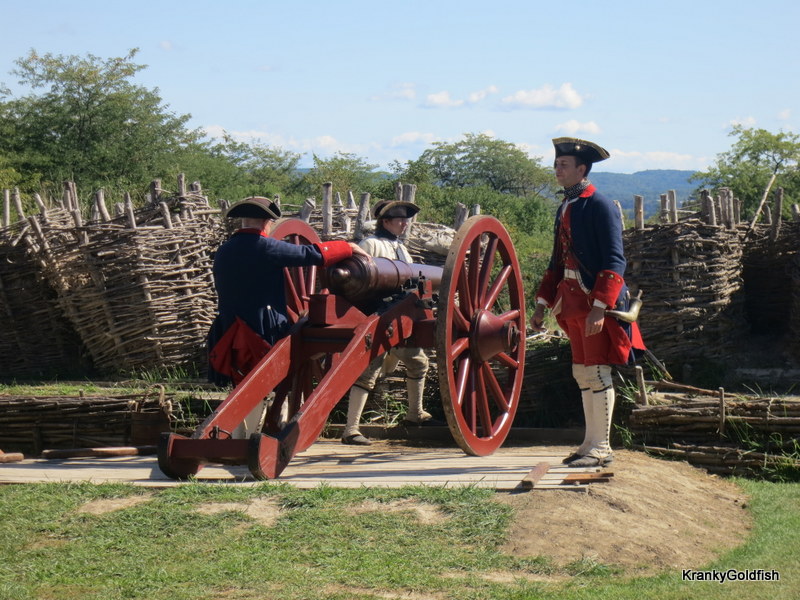
Loading one of the field pieces. Wicker baskets full of earth were used at the time to provide cover when stone fortifications were not available.

The cannon made a very satisfying boom!, and they loaded and fired it a second time, just so we would know it wasn’t a fluke.

We had a quick lunch at the cafe and went back to look at the fort some more. One of the good things about being in a market of 300 million people is that you get access to a wider range of snack flavours. These were very tasty (but could have used more horseradish).

In a farm beside the fort there were cattle grazing. Mr Cow gave it his best, but coudn’t quite fit in.
We really enjoyed Fort Ti. It might not be quite authentic, but there’s a lot of content and it’s very entertaining.
But we had to leave as we had a long drive to our next night’s stay. It was another good drive, on good roads through hills and mountains with plenty of landscape to see. But we had stayed a bit long at Fort Ti, so didn’t stop to take a lot of pictures.
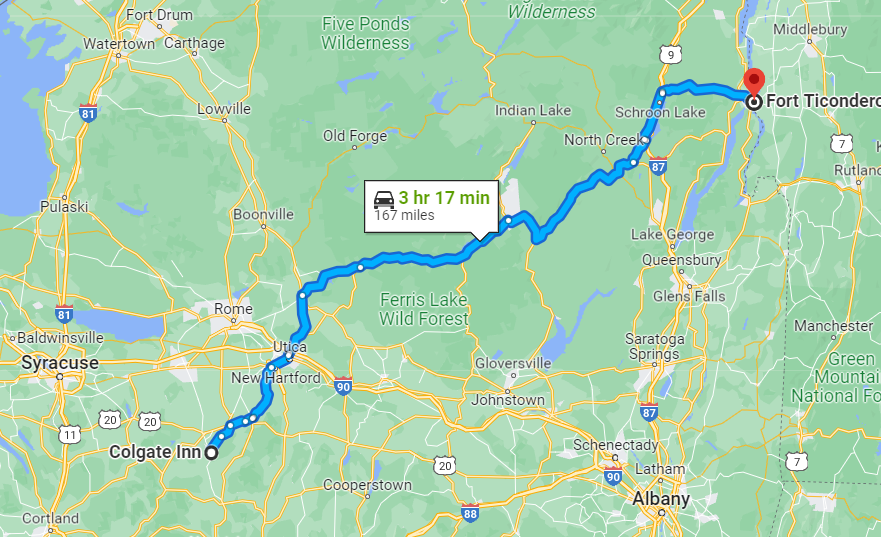
Hamilton is another small town in upstate New York, now also mostly known for the local university. We had booked in to the Colgate Inn to stay for the night, and it was lovely. We had considered staying in Utica or Rome, being bigger towns nearby, but Hamilton was just right for what we wanted.
Tourist tip – college towns make a great place to stay. Compared to non-college towns the same size, they tend to have good quality accommodation for parents and alumni to stay in when they visit, and a wider range of restaurants, because college kids love to eat and generally can’t cook for themselves when living in dorms. Just make sure you don’t try to stay there at Homecoming or in fresher’s week, everything will be booked solid.
Having said that, we were tired and it was kind of late so we just ate at the Inn’s restaurant, The Tavern.

The beer was nice, and those two piggies are having so much fun! And on the right is a pumpkin ale. In the lead-up to Halloween, Americans become obsessed with all things pumpkin. Pumpkin jack-o-lanterns, pumpkin pie, pumpkin spice lattes, and pumpkin beer. The beer is infused with the spices used in pumpkin pie – cinnamon, clove, allspice, nutmeg and more – and depending on the brewery, sometimes with pumpkin itself. Don’t worry, it gets strained out before bottling, the beer isn’t chunky.

I mentioned Maine scallops before. Seared scallops on corn cakes with a herb puree were huge, meaty and delicious.

Southern fried chicken, I mean, we weren’t in the South but I couldn’t pass it up. And it was crispy, juicy and tasty, and so big! I think there was nearly half a chicken on that plate.
And so we wandered back up to bed, tired from a long day and full of good food.
Tomorrow is a really big day. We travel 128 miles to have garbage for breakfast, have a Kodak moment, and take a big fall.
-
Day 13. Portland to Middlebury
In which we travel the back roads of the Granite State, visit a historical hotel, sip syrup and try beer soup
As I mentioned in yesterday’s blog, driving on freeways and interstate highways is kind of boring. If you are in a rush, sure, it’s the fastest way to get there, it’s smooth and low-stress. But all you get to see is the cutting the highway is going through, or the trees planted on the side of the road, or the next in the seemingly endless – and endlessly repetitive – series of petrol station and fast-food outlet rest stops. It’s dull. If you really want to see the country, the interstate will not show it to you.
And, as it happened, there is no interstate heading west/north-west from Portland to where we wanted to go. So we started off on Route 302 and kind of wandered our way through the lakes and hills of western Maine.
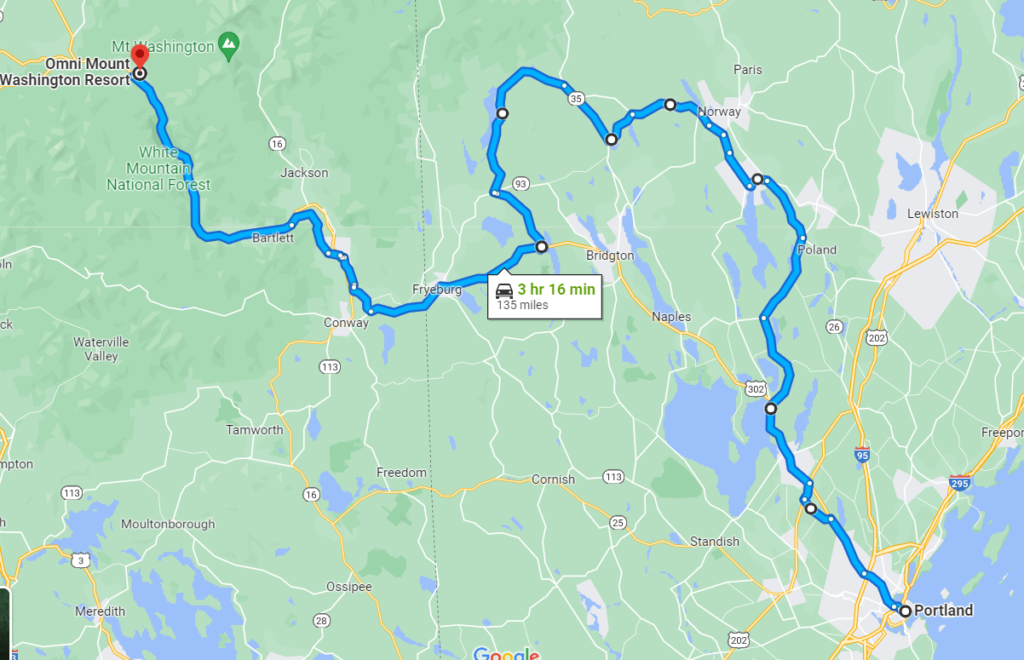
The map above is just an approximation, we left the state routes and wandered along country roads as the mood took us. We kept heading generally west, with an eye on the time so we could be at Mount Washington for lunchtime.
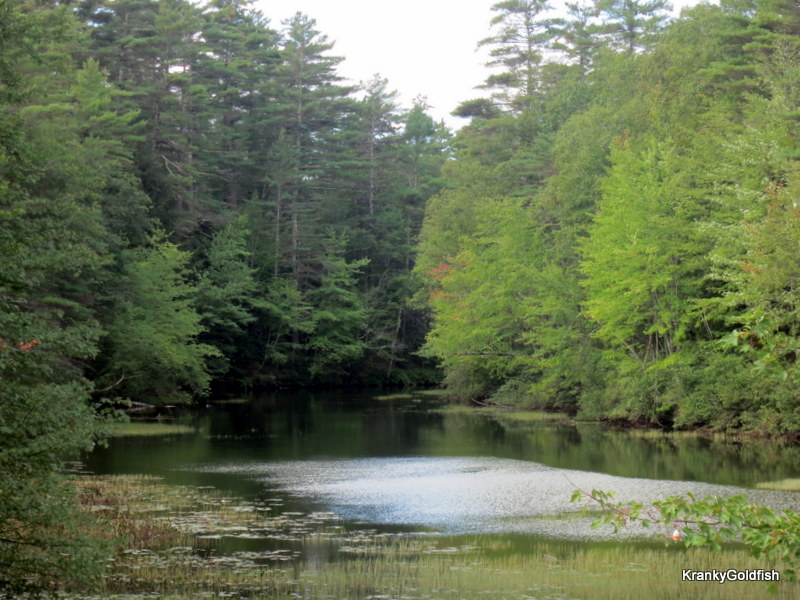
And we stopped as the mood took us, also. Such as by a river …

… or by a different river, seen through some trees …

… or another river, seen through the railings on a bridge. Yes, they have a lot of rivers! And don’t worry, it was a very quiet road and there were no cars around except ours, we were being very safe. And see that tiny little flash of bright red there! We were sadly a couple of weeks too early for the real New England fall foliage display, but there was a hint here and there of what it might look like.

For a change, we stopped by one of the approximately 6,000 lakes of Maine. And no, we don’t know this one’s name.

Maybe I need a better camera. I swear the view of clouds pooling over the top of the range of hills was a lot more majestic than it looks here.

Mr Cow on a hillside in Maine, looking toward far horizons. He really does have the brooding presence of a young Brando, doesn’t he?

And we stopped to get petrol, of course, and we looked on the shelves of the gas station to see what we could see.
To our Australian readers, Alpo – to the left of the photo – is an American brand of dog food. Chef Boyardee – to the right – is a brand of human food. But it is remarkable, when you see them together, just how similar the packaging is, and how close they are on the shelf.
I see no possible way that could cause a problem.

And eventually we arrived at the Mount Washington resort, also known as the Bretton Woods hotel.
It’s a big, beautiful building in that very classic resort hotel style. It was built in 1900-1902 and has 269 guest rooms. In summer you can bike, hike, golf and fish, and in winter you can ski, snowboard, skate and apparently even go dog-sledding. We had lunch at Stickney’s, the pub/steakhouse in the hotel, and there’s a formal restaurant and several bars. If you’re not staying at the hotel it’s wise to book as, quite sensibly, hotel guests get first priority for tables.

The foyer is vast, and elegant in a simple and tasteful way. The Breakers it ain’t!

The hotel is big enough to have its own Post Office branch. Or maybe it’s just that the guests were influential enough.
But aside from looking kind of like the inspiration for the hotel in The Shining (it wasn’t, although there is a passing similarity), Mt Washington Resort is most famous for the Bretton Woods conference that took place here in 1944.
The conference brought together senior finance ministers and officials from the members of the nascent United Nations, to design a post-war international financial structure. This would, hopefully, avoid the scourges of hyperinflation, trade wars and financial depression that had plagued the interwar years. The result was the establishment of the World Bank and the International Monetary Fund and a system of free currency interchangeability and pegged but adjustable exchange rates. This provided international economic stability, more or less, for nearly thirty years until the oil crisis of the mid-1970s, when it fell apart in a series of, well, inflation, trade wars, and finally stagflation which was only broken by a series of forced recessions. So let’s call that a qualified success.
The conference itself was another of those epic stories of financial and political shenanigans of the highest order. On the British delegation was John Maynard Keynes, the brilliant upper-class academic with a view of a radically egalitarian post-War financial order which would, coincidentally, keep Britain in its place as a pre-eminent financial power. On the American side was Harry Dexter White, a working class child of poor immigrants who didn’t complete college until his thirties, clever and methodical, a secret Communist sympathiser* who nevertheless set out to cement the US in the top spot, which involved removing Britain to a lower place.
The conference itself was a festival of bureaucratic dirty tricks including last minute agenda changes, reallocating policies between sub-committees until no-one knew who was approving what, and ultimately delivering the final treaty the night before signing with a few key alterations, leaving inadequate time for review**. We may think modern politics is dirty, but these old-timers were as sneaky as they come.
Spoiler : the Americans won. Making the US dollar the defacto currency of international trade put America at the top of the international financial heap for half a century and more, and they are in many respects still there.
And the conference room where the final signing took place has been preserved so that economics tragics like myself can visit and be dazzled by the lingering aura of history being made.
* White, among other things, provided details of American economic statistics and financial policy plans to the Soviet embassy in Washington DC. In return, crates of Russian vodka and Crimean champagne were left on his doorstep in the middle of the night. It was a simpler time.
** For a detailed history of the events, I can recommend The Battle Of Bretton Woods by Ben Steil.

This is my dazzled face Outside the Gold Room where the signing took place.

A list of all the senior delegates. I’m not quite sure why Canada had a senior rep there but Australia didn’t.

A display case with the flags of the attendees. I’m not sure if these are original or came later.

Mr Cow, basking in the auras.

The view from the front porch of the hotel is spectacular.

The hotel has its own golf course, of course, and you can see the ski runs on the hills across the road. And some red leaves! These are probably the reddest we saw on our trip, but let’s keep our eyes peeled as we go.

As we left we stopped for a last look at the hotel.

Our next leg of the day was to scoot through some more hills and mountains to get to Bragg Farm Sugar House, which is an old fashioned maple syrup farm. As I always say, when in Vermont, take some time to stop and taste the syrup.

Hills and mountains and country roads. The Mighty Sentra was not a great driving car by any shake of the stick, but this was a fun drive. Windy enough to be engaging (but not enough to be scary), and picturesque views around every bend.
Doreen : It was now getting towards late afternoon and while the scenery was lovely, I was a bit concerned we might arrive too late for my Vermont bucket list stop – Maple syrup sampling.

At Bragg Farm the Maple Sugaring or “sugaring” process of collecting the sap from maple trees and concentrating it into syrup is still done in the traditional way, tapping the trees by hand and collecting the sap in buckets. The season is from February to April and is weather dependent, requiring freezing night temperatures and a daytime thaw of about 5 degree Celsius for the sap to flow. It takes forty years before a tree can be tapped, and after that it can be done every year (in a different place on the tree) for as long as the tree is healthy which can be around 400 years.

The evaporator boils the sap containing 1-5% sugar concentration into syrup of around 66%. It takes many hours (1 hour per gallon) to condense the sap and from 44 gallons you get just one gallon (3.78 litres*) of syrup. On average a tree will produce between 10 – 20 gallons a season. If you want to see more of Bragg Farm visit youtube or see the current manufacturing process done by the Maple Guild.
* Yes, I know a gallon is 4.55 litres. American gallons are smaller because their pints are smaller, 16 fluid ounces instead of 20. So, if you are from the Commonwealth, just multiply the American gallon amount by 0.8308. Simple!

We bought a Maple Grading Sampler as a gift and a bottle of Very Dark Grade A. The syrup colour depends on on when it is collected, the later the season the darker the hue. It has been sitting in our cupboard for 3 years awaiting the right occasion or recipe to entice us, as once opened it needs to be refrigerated. However I have just read it can be kept indefinitely, frozen. Hmm so maybe pancakes are on the horizon soon . .

Back to David : It was a busy day with lots of driving. Too long, really, six hours is absolutely the most you should drive if you want to see anything along the way. And ideally four or so. By the time we got to Middlbury it was sunset* so we didn’t have time for a look around.
We had booked in to the Middlebury Inn, a lovely old-fashioned venue nearly two hundred years old. We dropped our bags, freshened up and went in search of dinner.
* The photo above is from the next morning.

We ended up at the Two Brothers Tavern, a handy 10 minute or so walk from the inn. There was a bustling bar but we felt like a bit of quiet after a long day, and retreated to the less populous and rather more peaceful dining room for our dinner.
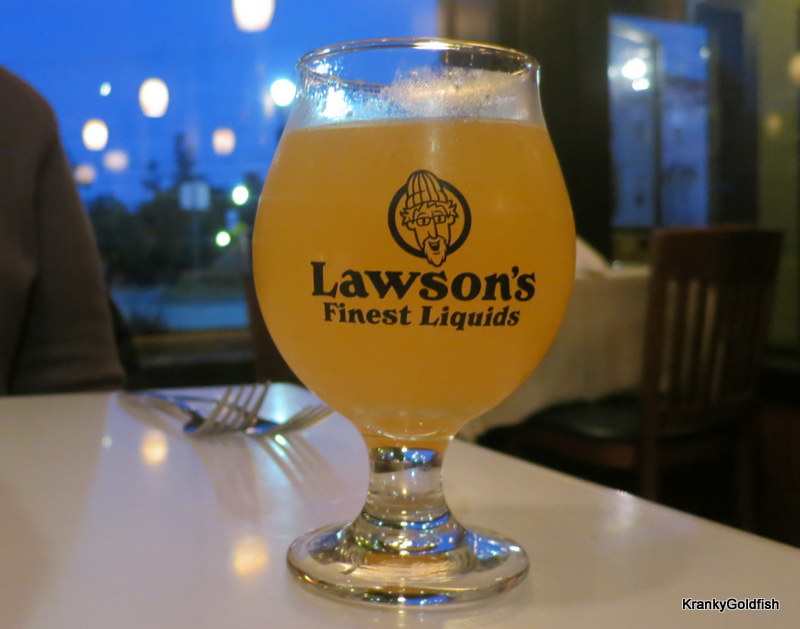
America has benefited from a brewing boom in the last few decades. Jokes about their beer being like making love in a canoe are well past their use-by date. Lawson’s Scrag Mountain Pils is a Pilsener-style beer, crisp and fresh with mild floral hops. It was delightful at the end of a long day’s drive.

And New England has been known for cider for as long as anyone can recall. Woodchuck Granny Smith Hard Cider is dry, light-bodied and tangy, and goes down a treat.

And Vermont is also known for its cheese. Put artisinal cheese and a strong brewing tradition together and you get beer and cheese soup (at the top of the photo), made from Cabot cheddar and Switchback ale. It was full-bodied but not heavy, and Doreen has asked me to make it a few times since we came back.
And at the bottom of the shot is a Plaid Salad, with red and golden beets, candied walnuts and crumbled sharp cheddar, Granny Smith apples and scads of healthy kale. Tourist tip – burgers and fries are yummy, but look after your body and have some greens now and then.
So that’s it for another day. Tomorrow we have a walk around Middlebury, visit a fortress that never was, and may or may not see a giant lake snake!
-
Day 12. Portland. Walk Duck Clam.
In which we take a walking tour, eat excellent rolls for lunch, ride in a mighty duck, and tread in the footsteps of Bourdain.
Walking around Portland

Yes, I’m standing in the middle of Commercial St, the main harbour road of Portland, and there are like three cars moving. It’s 9:30 on a Sunday morning, give them a break! So up we rose and wandered down the hill again. Portland is the most populous city in Maine, with about 66,000 residents in the city proper, and a total of about 250,000 in its metropolitan area. It was founded as a fishing town, and then grew as a trade port for goods from northern New England and, for a time, from Canada. But more of that later.
We had some time before our walking tour and we strolled around looking at odds and ends that caught our fancy.
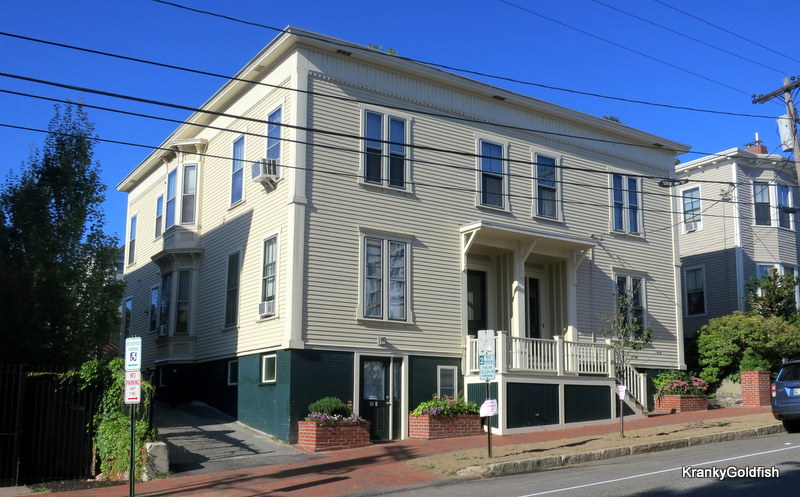
Portland has been a properous town through most of its existence and there are lovely houses, in that simple but elegant New England manner, to be seen all around.

Directly across the street was a less lovely example. With some … exciting electrical wiring going on.

Portland is still a working port, with fishing boats going out daily. Sunday looks to have been a day off for at least some of the fishermen though.

I am a sucker for a fresh market. I love to look around and see what is similar to what we get at home, and what is different. Harbour Fish Market called out to me, and Doreen was so kind, as always, to indulge me.

Sparkling fresh fish with their source proudly displayed.

Clams and oysters with very specific source locations. I wish we were staying somewhere where I could buy some and cook them for myself. Well, ourselves. I would share, obviously.

I don’t know what this building is or was when it was constructed. A warehouse? An office building, or a workshop of some kind? Its simple, handsome lines caught my eye.

Just in time we made it to our walking tour. A Walk in Time takes you around Portland, talking through the history and geography of the town over more than three centuries.

Charmingly cobbled Wharf Street was once the first street from the harbour. The buildings here were warehouses and chandlers for the working ships that fished and traded from the port. Now the harbour has been partly filled in and the waterfront is a block away; and the lane is filled with chic bistros for tourists to eat in. Which is progress, I guess.

The Maine Lobsterman is a semi-famous statue, originally cast as part of Maine’s exhibition for the 1939 World’s Fair in New York. The original was bronze paint over plaster (there was a Great Depression happening and funds were short) and was damaged beyond repair in the 1950’s. Gladly there was money available by then for real bronzes to be recast from the original; one is now in Washington DC and the other sits in a square at the corner of Temple and Middle Streets in Portland.

The Time and Temperature Building is a rather lovely early deco skyscraper near the commercial centre of the city. It is a Portland icon, recently in decline as an office building, but now there are plans to redevelop it as a lxury hotel.

Next to the T&T is the Fidelity Trust Building, a 1910 Gothic revival skyscraper. It’s also being considered for conversion from offices, this time to a residential building.
And can I just take a moment to point out the sky? No photoshopping going on here. From this day on we had almost continuous clear blue skies for the rest of our time in the US. A little haze now and then, some fog one morning driving to Albany, but apart from that it was mid-20s during the day and mid-high teens at night – celsius, obviously. Pretty much perfect holiday weather.

Portland City Hall is the fourth one the city has had. The first one was on a different site in the town’s old market square, and this one – built in 1909-12 in the Renaissance revival style – is the third on this site, the previous two having been destroyed by fires.
This seems like a good time to mention Portland and fires. They’ve had a few of them. Large parts of the city have been destroyed by fire on several separate occasions.
The settlement of Falmouth (as Portland was then known) was destroyed in 1676 in the course of King Philip’s War, a conflict between native Americans and English settlers. I haven’t found a definitive account but it is mentioned in some sources that the town was burnt out, or at least heavily damaged by fire.
In 1775, at the start of the American Revolution, Falmouth (it was not renamed until 1786) was bombarded by Royal Navy ships under the command of Captain Henry Mowat. Captain Mowat had been captured briefly by American militia earlier in the year and, considering himself to have been mistreated, took to his orders to “chastize” Falmouth (and several other ports in the area) with a great deal of gusto. Much of the town was burned in fires caused by the bombardment.
In 1866 on July 4th, the first Independence Day after the end of the Civil War, another fire broke out. Allegedly started by celebratory fireworks (or possibly a dropped cigar), it spread from Commercial Street by the waterfront though the town. 1,800 buildings were destroyed, including the new City Hall that had only been completed in 1863, and 10,000 people were left homeless. The intermittent band of parks and cemeteries that runs through downtown function now in part as natural firebreaks. And a nice place to sit and eat lunch.
In 1908 the replacement City Hall was itself destroyed by fire, fortunately limited to just that building. The new one is going okay, so far at least.

Diametrically across from the City Hall is the Portland Fire Department Downtown station. I like to think they have one fireman watching the City Hall at all times of the day and night. Especially when there are fireworks on.

Not far from City Hall is the birthplace of Henry Wadsworth Longfellow, who we met in Boston in his role as the writer of the largely apocryphal but very famous poem, “Paul Revere’s Ride“.

A little further down the street is the First Parish inPortland Unitarian Universalist church. Parishioners were coming out as our tour walked on past. Not gonna lie, I have no idea what Unitarian Universalist means in terms of dogma. It’s a nice building though.

Like much of New England, Portland was a strong location for abolitionism. Slaves fleeing the South passed through here on the underground railroad, and the people of Portland provided moral and material support for the fight against slavery. Portland’s Freedom Trail reflects that fight, rather than the War of Indepedence of the Boston Freeedom Trail.

Part of that support is embodied in the Abyssinian Meeting House. Built in 1828 it was a centre for worship, education and social organisation for Portland’s African-American population. It is currently in the process of restoration.

Another stop on the Freedom Trail. Charles Eastman was a black member of the Abyssinian Church, and clearly an active one. As an aside, it’s interesting how meaning changes over time. When we think of preserving rare animals, taxidermy is not the first approach that comes to the modern mind.

The Grand Trunk Railway building stands on the corner of India and Thames Streets, near the harbour.
The Grand Trunk Railway was a big part of Portland’s history from the mid-19th century into the 1960s. Originally a development to enable commerce within Canada, it was expanded south into the US over time, including a branch to Portland. Portland was (and of course still is) a deepwater port that is ice-free through winter. This enabled it to function as an export point for Canadian commodities, primarily grain in those days, and an import point for, well, imports. The railway terminus was a sprawling complex over that part of town, and a key part of Portland’s economy.
The completion of the St Lawrence Seaway in 1959 allowed ocean-going ships to access the Great Lakes from the Atlantic year-round, and sealed the doom of this part of the Grand Trunk. The railway closed, the tracks were torn up, the buildings were demolished – apart from this one, which now serves as a branch and offices for the Gorham Savings Bank.
And while Portland is no longer a major port for trans-Atlantic shipping, the deep-water harbour and year-round access make it a good venue for a more modern type of shipping.

The tour having taken us on a loop around town and back down to the waterside, we went looking for lunch. And as I always say, when you’re in Maine, eat lobster.

The Highroller Lobster Co. embraces lobster rolls and plays sporty riffs on them like a jazz musician looking at the classic, simple rolls we had at Luke’s Lobster in Boston and deciding, No, I want to do something different with that. Yes they have lobster rolls, of course, with many different sauces. Also lobster tacos, lobster corn dogs, lobster salads, bacon lobster and tomato sandwiches, and many more things.
We had … lobster rolls. And they were good, plenty of sweet meat, salad and flavoured mayo that was not so strong as to detract from the star ingredient.

Lobster roll, roasted pepper mayo 
Lobster roll, lime and jalapeno mayo Duck Duck Sail
Our activity for the afternoon was to take a Maine Duck Tour. Ducks, or more properly DUKWs, were built in World War II as amphibious trucks. A sturdy, waterproof hull with six-wheel drive and a propellor driven off the main motor via a transmission change, they were used in the European and Pacific theatres for beach landings, river crossings and for overland transport after the landings.

Nowadays there are a few surviving examples being used for touristy fun.

The tour takes you on a drive around parts of Portland, with an entertaining narrative provided along the way. A bit of history, a bit of geography, some local gossip and a few jokes thrown in for free.

The Duck then takes to the water down a boat ramp, engages the propeller, and navigates in a quite liesurely way around Portland’s bay. You get some nice views of the local birdlife…

… of parts of the city from the sea – this is Fort Allen Park …

… and Fort Gorges, built after the War of 1812 to defend Portland from the British, and obsolete before it was completed due to advances in naval artillery technology.
And other things too, it’s a nice ride and a good fun tour.
After the tour we wandered around a bit more before dinner.
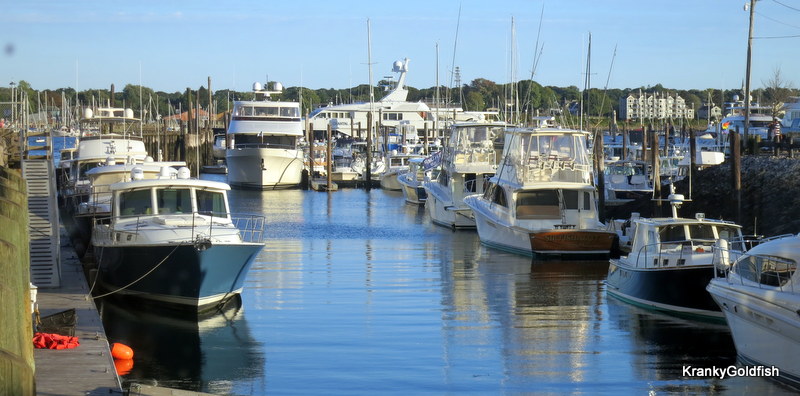
Portland is a lovely tourist town, with a picturesque harbour full of pleasure cruisers.

One dock over you can find the proper fishing boats that are for working, not pleasure. A lot less picturesque, and also kind of rickety. But perhaps more substantial in a way of its own.

Our wandering led us to the back side of one of the docks. It presents a remarkable patchwork wall of old boards, corrugated metal, plastic sheeting and barely two windows alike. I love it!
Clamming up for dinner

J’s Oyster is a Portland institution, made semi-famous by Anthony Bourdain in an episode of No Reservations in 2009 or so. It was opened in 1977 by Janice Noyes as a place for the local fishermen to have a beer and oysters when they came off their boats, and is owned and run now by two of her daughters. An unpreposessing building right by the docks, the ambience is basic (I suspect unrenovated since 1977), the food is simple, based around exquisitely fresh local seafood, and the beer is cold and not too expensive. They don’t take reservations, so if you don’t want a long wait you should get there early. We got there about 5:45pm and the joint was almost completely full; gladly there was a two-top free in a corner and we actually even had a nice view of the docks rather than the parking lot.

The oysters were an example. Huge, chilled raw local oysters with that fresh, slightly briny tang to them, accompanied by some ketchup splodged in a plastic container with a big dollop of horseradish and some chunky wedges of lemon. They were pretty much perfect.

Oysters Rockefeller are one of Doreen’s favourite treats, baked with a sauce containing spinach, cheese and bacon and topped with breadcrumbs.

And as I always say, when in Maine, eat clams. Steamed clams are served by the bucket, and you stick them with your little plastic fork, give them a shake in the bowl of hot water to let you shake any sand or grit off, then dunk them in some melted butter and maybe give a little squeeze of lemon or hot sauce.

These little babies are soft-shelled clams, also known as “steamers”, because that’s how you cook them, “longnecks”, for hopefully obvious reasons, and “pisser-clams” for their endearing habit of pointing their siphon out of the sand and delivering a squirt of water when disturbed.
And even though they look kind of like the monster in a sci-fi horror film, they are tender and delicious when cooked properly.

This dish is listed on the menu as “raw scallops”, and it lived up to it’s name. It’s all the fixings of the oyster plate, jazzed up with a gratuitous lettuce leaf and a generous pile of fresh scallops. Maine diver scallops are perhaps the best in the world, although the Scots would disagree, and they put Australian bay scallops to shame. These were tender and sweet and exquisitely fresh.

Our last dish was “Crabby Janice”, which is a bed of crabmeat and Rockefeller sauce, topped with mornay sauce and breadcrumbs and baked. It was a tasty, creamy, warming dish with a generous amount of crab. The slaw was nice too, with poppy seeds again which seems to be a bit of a regional thing here in the north-east states.
And that was it for the day. We walked up the hill again to our hotel and did a bit of route planning and booked a room at a nice inn in Vermont for the next night.
Tomorrow : we leave Portland and drive through the back roads of Maine and New Hampshire, and you get to see me go all gushy when we visit the spiritual home of the post-World War Two financial system. This will be a real treat for the finance geeks!
-
Day 11. Swansea to Portland
In which we see how crazy rich Vanderbilts used to live and drive through four states! in a single day.

This morning we rose early and after a cheering breakfast – seriously, an egg and bacon toastie and a cup of coffee and I can face just about anything – we climbed into The Mighty Sentra and drove down to Newport. Too early, in fact, because we misread the opening time for The Elms and arrived an hour early.
Ah well. We wandered down to the waterfront at Newport, summer playground of the rich and richer, and looked at shops and boats. It was about 10am on an overcast Saturday morning and surprisingly little was happening.

Boats at Newport. I guess these are rich people’s boats? And we had only meant to have a quick look at The Elms, so by the time that house actually opened we needed to head off to The Breakers, where we had a tour booked to attend.

Main gate of The Breakers The Breakers is the mack daddy of Gilded Age mansions. It was built in about 18 months in 1893-1895 after the previous building here burnt down in late 1892, and served as the summer house for the Vanderbilt family for about 40 years.

The Gatehouse at The Breakers The Gatehouse was the residence of the property manager. Even though the family only lived here for 10-12 weeks each summer, there was a maintenance staff of a dozen or more year-round.
The Gatehouse was also where we started our tour. Beneath the Breakers takes small groups on a guided tour downstairs to the cellars and beyond. Because the previous house had been destroyed by fire, Cornelius Vanderbilt II required the new house to be as fireproof as possible. It was built with a steel frame and the building’s boilers were located under the Gatehouse, nearly a hundred yards from the house proper. Piping carried steam and hot water from there to the house through a series of tunnels and rooms. As well as the coal storage and boilers you can see the original (and still functioning) 1899 fuse box from when the house was electrified.

Part of the tunnel complex 
Spooooooky. No, it’s not a ghost, it’s our tour guide. 
An authentic 1899 fuse box. Huuuge copper switches, and yes, it still runs (some) power to the house. 
Also under the house was the wine cellar. The family held extravagant balls and parties frequently during their short summer stays, and brought a complete cellar full of wine each year when they came from New York. When they stopped their annual visits in the 1930s, the remaining wine was just left behind.
Or so the story goes. Sceptical Dave thinks that at some point, the remaining maintenance staff would probably have gotten in there. “Just making sure it hasn’t spoiled, boss.” But, it’s a good story.
The tour took less than an hour and gave some fascinating insights into the infrastructure that kept the great mansion running. Tickets are USD18 as at the time of writing and we strongly recommend it.

The main house from the front drive The Breakers is just breathtaking. It is a glorious statement of excess and wealth that stands out in a period that was known for excess and wealth. The Vanderbilts in the late 1800s were among the richest people in America, with a family fortune built from shipping and railroads. Cornelius took the building of the new mansion as a challenge to create the most opulent, luxurious and modern house imaginable.
And he succeeded.

The fun starts in the entrance hall. It stretches the height of the first and second floors, maybe fifty or sixty feet? Marble tiles, ornamental carvings as far as the eye can see. I mean, just assume I write that at the start of every paragraph, because it’s true everywhere.
It’s a level of ornamentation that to our modern tastes seems ridiculously over the top. But it was the style at the time.

Stairs from the entrance hall heading up to the second floor 
A small fountain evoking a Roman villa, nestled into the back of the stairs in the picture above. 
The music room 
The billiards room 
The dining room I have to admit, I find it almost impossible to imagine living in a place like this. The scale, the grandeur, the impracticality, are all just beyond me.
In my internal visualisation of life here, I’m not living in the fancy bedrooms, or dancing in the fancy ballroom.
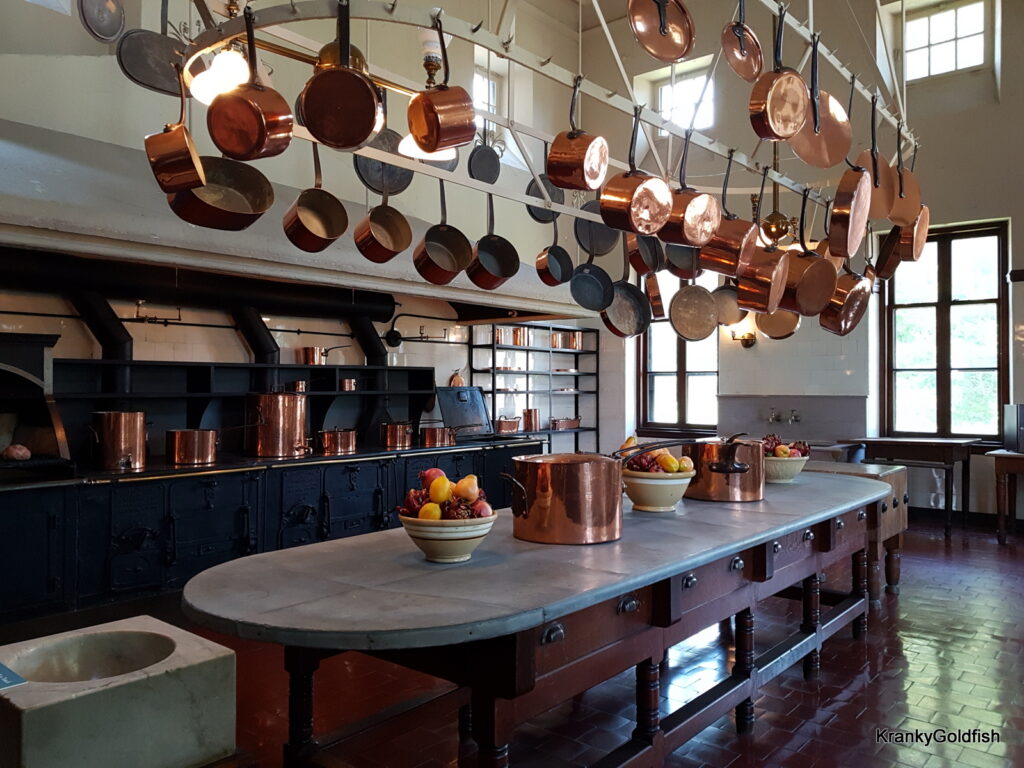
Nope, I’m here in the kitchen, making the snacks.

One of the bathrooms. Possibly the least ornate of the rooms (apart from the servants’ quarters of course), and even almost tasteful by modern standards. But what’s that little floor-level basin for at the right? If anyone knows, please tell us.

The baths at The Breakers famously had multiple water sources available, and taps to match. Public health and disease were big issues in the late 19th century – two of Cornelius’s children had died very young – and the Vanderbilts didn’t really trust the Newport municipal water system of 1894 to deliver uncontaminated water to their standards. So rainwater was captured, and seawater was pumped up from the Atlantic below the cliffs, and bathers could take their pick.
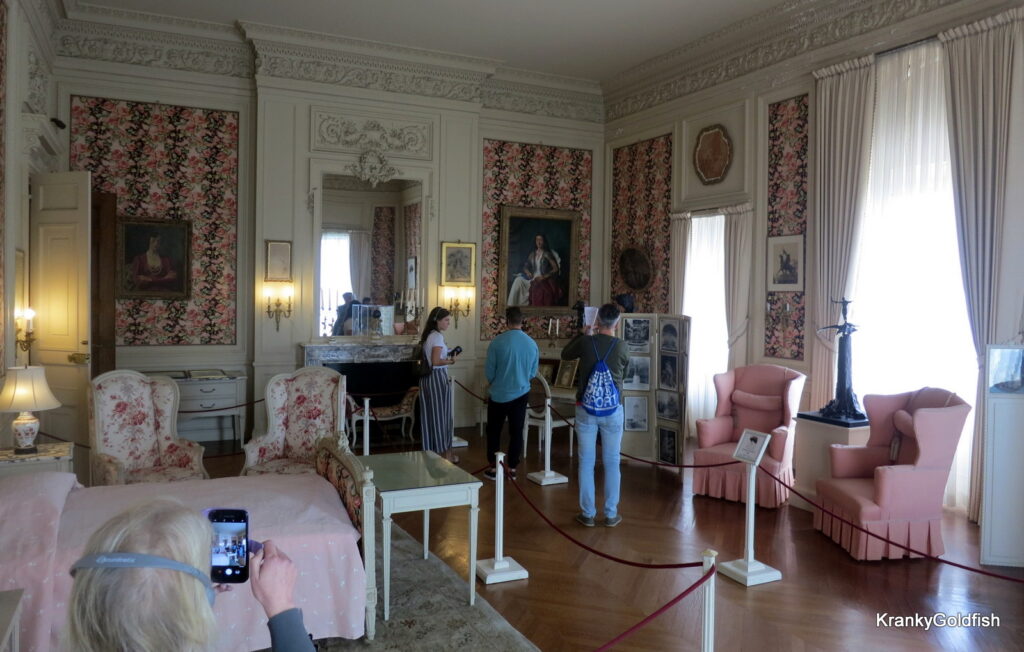
Gertrude Vanderbilt’s bedroom. Cornelius’s and Alice’s daughter, in her late teens when the house was built, she went on to a career as a respected sculptor. The bedrooms are almost on a human scale.

A loggia at the rear of the building looks out over the Atlantic. Below the edge of the lawn are cliffs, at the base of which beat the breakers for which the house was named.

The gardens of the house are also beautiful and well worth allowing time to look around. Interestingly little of the gardens are original; they were almost entirely destroyed in the great hurricane of 1938.
So that’s The Breakers. The Vanderbilt family used it regularly for less then 40 years, as Cornelius died in 1899 and after his wife Alice died in 1934 the next generation were unwilling or unable to spend the time and money to maintain the house and the lifestyle associated with it. When property taxes were introduced in the 1930s the estate became a financial burden to the family, and in 1948 it was leased (and later sold) to the Preservation Society of Newport County who keep it and numerous other mansions open to the public. The family has an enduring right of residence, and a few descendants have apartments to this day on the third floor, which was originally rooms for visiting friends and servants*.
It was a great visit; we spent probably three or four hours there and wish we had time for more.
* The family and any guests brought their servants with them of course. The third floor had quarters for thirty servants, with the rooms double-stacked with 9-foot ceilings** compared to the 18-foot height of the floor as a whole.
** If that sounds pokey, it’s still higher that the 8’6″ which is the minimum height for a room these days.

Traffic disruption in Boston. There’s a surprise. So it was back into The Mighty Sentra and north to Portland Maine, our destination for the night.
Mostly we were just motoring up the I-95, which is like driving on any big modern freeway not in an actual city. Good road, smooth traffic flow, kind of boring. I will say that as a driver from Australia, the land of traffic cameras, the behaviour of American drivers was a bit of a shock. Speed limits in the US seem to be more of a guideline than a rule. Driving at the speed limit (which I, of course, unfailingly did) results in everyone else leaving you in their dust. Ten miles-per-hour over the limit seemed pretty normal, and fifteen was not unusual. Which given that some sections of the I-95 have a 75 mph limit meant that some drivers (definitely not me) were scooting along at about 90 (which is 140 kmh in Australian).
I toyed with the idea of driving through some of the coastal towns north-east of Boston, some of which are the inspiration for H.P. Lovecraft’s fictional Innsmouth, but alas time was not on our side.
And so we passed quickly – very quickly – from Rhode Island through Massachusetts and New Hampshire to Maine, arriving in Portland a little before dusk. Four states in one day! Though they are smallish states, and honestly New Hampshire was a quick in-and-out. But I’m counting it.
We checked into the Holiday Inn for our two nights in town, and wandered down to the main street for a quick orient and stroll. As dark fell we stopped in Gritty’s for a nice casual pub meal. Gritty’s is a brewpub and we had some fine local beers and ciders as well as tasty food.


Fried clams with slaw and fries. When in New England, eat clams. 
Cheesesteak roll and onion rings. Okay, not a New England staple, but we weren’t going to Philadelphia so may as well have one here. And so back to bed. The ten minute walk uphill to the hotel was good for our character, and a handy leg-stretch after a long drive.
Tomorrow, we get our tourist on in Portland. No, not that one. The one on the right-hand coast.
-
Day 10. Boston to Fall River.
Blacktop, Battleship, Baccala
In which we collect a car, drive on the wrong side of the road, which is the right side of the road, see several ships, and eat Portuguese food.
On the road
Driving in a foreign country for the first time can be daunting; different road rules, different cars … wrong side of the road! You get used to it pretty quickly, but the first time can be a trial.
Tourist tip – ease into it. Don’t pick up your car in the middle of the city and make congested urban driving your first experience. We booked a pickup a few kilometres out of town in a location where we could quickly and easily get onto I-93, which would be the first part of our route today. Driving on the freeway for the first bit lets you get used to your car, where the controls are and all that kind of thing, without the stress of turns, stoplights or anything much in the way of having to interact with other traffic. So we Ubered down to the car lot and picked up our car for the next ten days or so.
Also, get an E-ZPass. I feel like I shouldn’t need to say that, but I will anyway. Automated tolls are the only way to go.

This is from a few days later. Mr Cow is enjoying the view somewhere in Vermont. And I can say with confidence that it was a car. Our Nissan Sentra had four wheels, an engine, a body and everything else it needed to qualify as a car. We couldn’t get our phones to sync with the infotainment; it had the get-up-and-go of a tree sloth on valium; getting up to speed on the interstate meant putting your foot down quite hard for quite a while; and it had all the interior quality that you would expect from a cheap, fleet econobox. I’ve never owned a car with worse road handling (although I rented a Mitsubishi ASX once which was about as bad).
In it’s defense …. ummm? It was economical to run, cheap to hire, and even for long driving periods the seat wasn’t too uncomfortable. And, side note, I did all the driving as Doreen didn’t feel comfortable with being on the wrong side of the road. It’s okay, she has agreed to do all the driving when we are in Germany next (although I get at least one go on an autobahn).
So off we went, down I-93 to the 24 – not a difficult or long drive, in the spirit of easing in gently – and on to Fall River.

Or, to be more precise, to Battleship Cove.
Battleship Cove
Battleship Cove is a naval museum (mostly, there are a few non-naval exhibits) located in Fall River, Ma. The pride of the collection is the battleship USS Massachusetts. In 1962 when she was being stricken from the reserve, a public appeal raised enough funding to buy the ship and set up a trust to maintain her as a museum ship.

Photographs struggle to do justice to these giant machines. 210 metres long – the length of a Melbourne CBD block. 38,000 tons of metal, another 7,000 tons of fuel, water and supplies. 2,500 men. All being driven through the ocean at 50 kilometres an hour.* A photograph like the one above lacks the perspective to show how immense they really are. And a photograph inside the ship only shows you a distance of tens of feet.
* Did I mention I’m a huge naval nerd?

USS Massachusetts from the bow. Showing scale from the human to the immense can be a challenge. Maybe this photo is better. The fore turret is about two or three times the height of a person. The bridge is about twice as high as two turrets. The top of the conning tower is about twice as high as the bridge. We won’t count the radar and comms masts. So that’s, what, forty metres? The height of a ten story building. Plus the distance from the waterline to the main deck, another four stories. That’s big. Really big.

Looking upwards at the main mast and the forward director from the bridge deck. 
Enlisted bunks on the Massachusetts. 2,500 people living in that space didn’t leave much room, and privacy was not an option.

The enlisted heads also left a lot to be desired. No slow-close hinges on these toilet seats. Also, no doors. I wonder what rank you needed to be to do your business in private?

While there wasn’t a lot of creature comfort, sailors did have access to the latest in 1940s dental technology.

As a keen cook and eater I always get excited by kitchens. Here, a row of giant steam kettles to cook soups and stews on an industrial scale. I mean, 7,500+ meals per day doesn’t leave time to position microherbs with tweezers.

And the bakery is on a similar scale. I don’t have a decent photo of it but there is a recipe in the bakery for a batch of biscuits (that’s savoury scones in Australian) . Just shy of 300lbs in a batch.
- Flour ………………………. 200lbs
- Sugar ………………………… 16lbs
- Salt ……………………………… 5lbs
- Baking Powder ………… 22lbs
- Shortening ………………., 48lbs

But creature comforts were not completely lacking. American battleships and aircraft carriers were fitted with ice-cream machines and had a soda fountain installed. And where there’s a soda fountain …

Being attached to a US naval force was very popular with Commonwealth ships in WWII because of the availability of ice-cream and soft drinks. It was equally popular with the American ships, as they were alcohol-free (medicinal reasons excepted), while Commonwealth ships had a daily issue of beer or rum for all hands (medicinal reasons excepted). I’m not saying swaps happened. But … swaps happened.
But USS Massachusetts was, of course, a battleship. It wasn’t all eating, sleeping and pooping.

The fire-control calculator was the height of 1940s electro-mechanical calculation. Battleships would be shooting at their targets from up to 20 miles (32km). In the 40 seconds or so it took for the shells to travel the distance, the target would have moved up to 500 metres. The calculator would account for the speed and course of the firing ship, and attempt to do so for the different speed and course of the target, air pressure, wind speed and probably other things too.

Shell hoists would feed ammunition from the armoured magazines below the waterline up to gun positions. These hoists would feed 5″ shells to one of the turrets of the ship’s secondary armament.

40mm anti-aircraft battery on the foredeck beside B-turret. Besides the main and secondary gun batteries, Massachusetts had over 100 anti-aircraft guns aboard. Their efforts no doubt contributed to her good fortune in getting through the war without any combat casualties.
But wait, there’s plenty more to see at Battleship Cove!

USS Joseph P. Kennedy Jr, a WWII Gearing Class destroyer, was converted to an anti-submarine fit-out in 1960. She’s a well-preserved example of the type and it was interesting to see the 1960s-era remote-controlled drone – you can see the helicopter hanger above the aft gun turret in the photo above.
Joe Junior himself is a fascinating and little-known footnote to history. Son of Joseph Kennedy and older brother to JFK, he was the beneficiary of Joe Senior’s ambitions and was groomed to go into politics and perhaps ultimately the Presidency. He served in WWII in the US Navy as a patrol bomber pilot, and was killed in what sounds like such an unlikely circumstance that it should have come out of a novel, not real life. The Aphrodite project was a B-17 bomber crammed full of ten tons of high explosive. Designed to be taken off by a pilot who would then bail out, the bomber would them be remotely guided from a chase plane to impact its target. Joe Jr volunteered for the project, and during a test flight the bomber exploded, probably due to a short circuit, killing him and his co-pilot.
JFK was steered into politics in his brother’s stead, and history was made.

Battleship Cove is also home to the US Navy PT boat museum. The light, fast torpedo boats (as seen in the excellent documentary series “McHale’s Navy”) were known as “mosquito boats” for their nasty sting, and each boat squadron had its own insignia.



Also available to tour is the USS Lionfish, a Balao class submarine also from WWII. We’ve been on a few submarine museum ships and were short on time, so we skipped the Lionfish on this visit.

Finally there is the USNS Hiddensee, a Cold War era guided missile corvette built in the USSR, operated by the East German navy, transferred to the German navy on reunification and then to the US Navy in 1991 who used her for testing and systems evaluation before she was decommissioned in 1996. Very interesting to look at from the dock, but there is no access on the ship for visitors.
So that’s Battleship Cove. If you are into naval history there is a wealth of content there. We got there a bit before 10am and left shortly before 5pm with just a short break for a sandwich at lunchtime.
Turning Portuguese
Massachusetts has a strong Portuguese community. There was a wave of immigration in the late 19th century and again after the Second World War, and many of the immigrants settled in Massachusetts because of the availability of unskilled jobs in the mills and factories of New England. One of the happy side-effects of this is the availability of delicious Portuguese food.

Sagres is a delightful family-owned restaurant in Fall River. There is a bar area, a dining room area, and a large wine collection visible through glass walls from the dining room.
We had never eaten Portuguese food before, so after a long day walking around ships and a (deliberately) light lunch, we headed there to try as much variety as possible.

Ameijoas Espanhola, littleneck clams in a tomato broth rich with garlic, onions and parsley.

Lulas, fried calamari with lemon and a dipping sauce.

Piexe a Portuguesa – fresh cod cooked in a tomato sauce with herbs and onions, topped with roast potatoes. Lovely flavours with the potato cooked to that perfect degree of rich crispy brownness.

Bacalhau a Gomes de Sa – salted cod which has been soaked then baked with onion, potato & garlic, garnished with olives and chopped boiled eggs. The fish was dense yet tender and packed with flavour.

Classic Portuguese flan, a delicate baked custard. Light, sweet, eggy. We were so full we definitely didn’t need this – we took half the main courses home to have for lunch the next day – but the waitress talked us into it and who were we to say no?
All the food was delicious. Simple, strong, robust flavours combined in traditional Portuguese dishes.
So back to bed. We stayed at the Holiday Inn in Swansea, just a ten minute drive out of Fall River. It was cheap, convenient, perfectly pleasant and with a breakfast buffet included in the price with hot eggs, bacon and sausage was a good deal.
Tomorrow, we head off to Newport, Rhode Island. Where we go Full Mansion.
-
Day 9. Boston. Music, Mafia, Mooncusser
In which we imbibe some culture, walk some more, and eat some delicious seafood.
The Yarts
Our last full day in Boston! All those days and we haven’t even been to a museum yet. Well, the Tea Party visit was technically a museum. And so was the central building at the Navy Yard. But they were history museums, not the type with paintings, and sculptures, and other forms of art. So we jumped on the T and public transported ourselves off to the Boston Museum of Fine Arts. Conveniently located right by Museum of Fine Arts station, although to be honest it’s more like a slightly enlarged tram stop.

A proper T station If you look up the population of Boston, you will see it is about 700,000. Why does a city that size have an elaborate underground railway system and so many skyscrapers? Of course, Boston proper is just the old city. The peninsula and a couple of inner suburbs are Boston – anything north of the Charles river doesn’t count, nor anything west of Brookline or south of the Neponset river. Even Cambridge (you know, where Harvard is) isn’t part of Boston for this purpose. The greater Boston area, however, covers almost a third of the state and has a population of about 5 million. So there you go.

Doreen : MFA has many fine collections but I really only wanted to see one, the Musical Instrument collection and I was not dissappointed. A headset is a must on arrival, for a few dollars extra it transformed the experience. I was no longer glancing at sterile containers but feeling the emotions of the composers and listening to the stories of these instruments.

As a flutist or more accurately an owner of a flute, I found it fascinating to see the variety of models and materials and the impact on the sound. I have never seen a glass flute before and I was delighted by it’s lovely timbre. Part of the experience is that there are recordings, available through the tour headsets, of short pieces played on the actual instruments being exhibited. It is also wonderful that I can revisit the memory by listening to it again on YouTube.

This wooden flute is a very pretty instrument and had a lovely warm tone. I can’t find a recording of this particular instrument but if you are interested in hearing what one sounds like here is Emi Ferguson playing J.S Bach.

There have been some truly wacky instruments developed though the ages. If you look closely you will see the tenor trombone has a tongue. Guess what – it moves when it is played! Take a look and hear it played.

I eventually managed to tear myself away from the instruments, and just as well as there is so much to see. We realised the couple of hours we allotted to the museum, was not nearly enough. The two portraits, above and below, are by Gilbert Stuart and are of George Washington. Does the top one look familiar? It is the original work that ultimately became the portrait on the one dollar bill.

George Washington at Dorchester Heights, full-length in uniform, standing by a white horse, holding his bridle in his left hand and his chapeau in his right. Commissioned by Samuel Parkman in 1806.
David : In the late afternoon we did a Boston by Foot tour, The Dark Side of Boston. Was an enjoyable tour, nice small group with lots of historical information.
Topics include the Boston Irish mob, the Boston Mafia, the famous Brink’s payroll robbery, Prohibition and the seedy side of life in the North Side. But those aren’t terribly photogenic, are they?

This lovely scenic spot in the distance is the Bunker Hill monument on the left and the USS Constitution Museum, with the Constitution herself visible towards the right. Where we were standing was the site of the Great Molasses Flood of January 15, 1919. Which sounds kind of funny, but a twelve-thousand ton tank of hot molasses burst, killing 21 and injuring 150 people. The tragedy was the cause of a number of revisions to construction and industrial safety regulations.

Dinner that night was at the Mooncusser Fish house. What on earth is a mooncusser? Well, back in the olden days there were people known as land pirates. They would place lights along the shore at night to mimic beacons and lighthouses, but in places so as to lure ships to crash on rocky shores, where the land pirates would loot them. This trick would only work when there was no moon for the ships to see the coast, so the land pirates would curse the presence of a good moon, hence moon-cussers. If you are of a certain age you may remember a children’s novel titled Moonfleet*, in which this trick was a plot point. It seems like a very roundabout way to derive a name, but if 19th-century police were known as “mutton-shunters“, I guess this isn’t too bad.
Anyway, Mooncusser is a rather upmarket seafood restaurant in the Bay Village area, just a couple of blocks south of the south-west corner of the Boston Public Garden and a pleasant twenty minute or so walk from our apartment. Inside, the decor is sleek and minimalist, white tablecloths, occasional dark panelling to define a row of booths down the middle, and polished professional service from the well-dressed servers.
* So reading the Wikipedia entry, Moonfleet is not just an obscure 19th-century novel I read in my primary school library forty-some years ago. It was made into a film, several stage plays and no fewer than three TV adaptations. In my defence, I had no idea.

We wanted to try as much of the menu as we could, so ordered four appetisers and a dessert instead of going the main course route. Variety is the spice etc etc.
Our first course was a squid salad in an East Asian style. Tender squid, Napa cabbage, bean shoots, a fresh and tangy nuoc cham dressing and some coriander for extra pep. I should do this at home.

Next was smoked bluefish pate, good strong smoke and fish flavours and creamy texture on light, crisp crackers.

Scallop poke. Slices of big fresh scallop in a light ponzu-soy dressing with a sprinkle of schichimi togarashi, a Japanese spice mix of ground chili, seaweed and other spices to give it a kick. Very nice, and if I could get good scallops here I would make this in a flash.
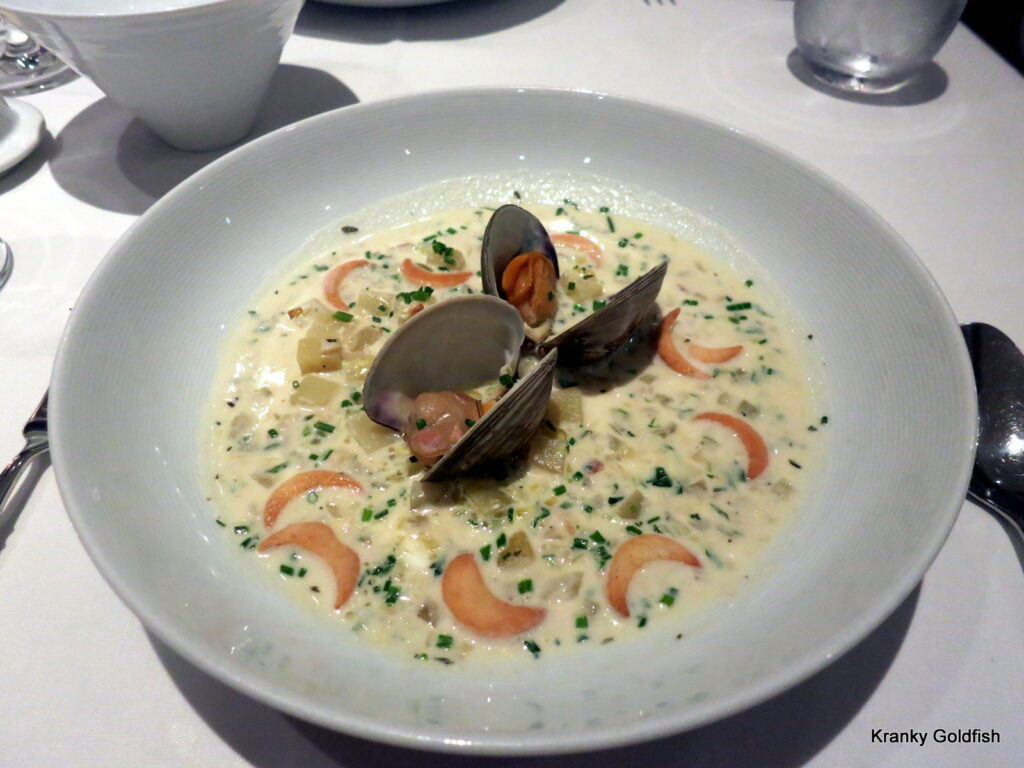
Mooncusser’s chowder was a completely different creature to Union Oyster House’s. This was the fancy restaurant version – a light, delicate, smokey seafood broth with plenty of seafood (halibut, clams and probably more), finely diced potatoes and fresh herbs. And both styles are great in their own way.

Dessert was a bete noir, a flourless chocolate cake rich and dark with some lovely fresh fruit and meringues to provide variety on the plate.
And off home we went, our last day in Boston. There were so many more things we would have liked to see, but holidays are finite and we did a lot with the time we had here.
Tomorrow, we finally hit the road.

